A COMPLETE GUIDE TO CRYPTOCURRENCY TRADING
 JOSH LAKA, TIM GENNES, ALEXANDRE HILLHOUSE, MICHAEL BROHIER
JOSH LAKA, TIM GENNES, ALEXANDRE HILLHOUSE, MICHAEL BROHIER

A COMPLETE GUIDE TO CRYPTOCURRENCY TRADING DR. MATTHEW HURST ROLAND GEORGE INVESTMENTS PROGRAM
CRYPTO 101
CRYPTO BASE CONCEPTS
BLOCKCHAIN APPLICATIONS
POTENTIAL TRADING STRATEGIES
ANALYSIS OF CRYPTO EXCHANGES
FUNDAMENTAL COIN ANALYSIS

TABLE OF CONTENTS
1.1 Exponential Returns or Investment Bubble? 1.2 Where Did It Start and Where Will It Go? 1.3 Is Reward Worth the Risk? 1.4 Hedging against Bubble Risk - A Correlation Analysis 4 4 5 6 8
2.1 Blockchain 2.2 Consensus Mechanism 2.3 Ecosystems & dApps 2.4 Smart Contracts 2.5 Bitcoin Dominance 2.6 ICOs 2.7 NFTs 2.8 Meme Coins 2.9 Decentralized Autonomous Organizations DAO 2.10 DeFi 2.11 Metaverse 2.12 Liquidity Pools 2.13 Automated Market Makers & Yield Farming 11 12 13 14 15 15 16 17 17 17 18 18 19 19
3.1 Web 3.0 3.2 Decentralized Currency 3.3 Smart Contracts 3.4 DAOs 3.5 NFTs 23 24 26 27 28 28
4.1 Long-Only Fundamental Analysis 4.2 Short Bitcoin Dominance 4.3 Yield Farming 4.4 Global Risk Factors 31 32 34 36 38
5.1 Centralized Exchange Platforms 5.2 Decentralized Exchanges (DEX) 5.3 Cryptocurrency Lending Platforms 5.4 Crypto Wallets 5.5 Recommendation 41 42 44 45 47 47
6.1 Market Movers 6.2 Alternative Infrastructure 6.3 NFT & Metaverse Adoption 6.4 Stablecoins for Defensive Portfolio 6.5 dApps & Governance 49 50 52 60 61 62 GLOSSARY 65
CRYPTO 101
EXPONENTIAL RETURNS OR INVESTMENT BUBBLE?
Currency of the future. Scam. Digital gold. Investment bubble. Cryptocurrency courts excitement and criticism from every corner of the financial universe. The lure of unprecedented returns draws many into cryptocurrency investment, while others decry the investment opportunity as speculative luck. Despite the broad spectrum of opinions, it appears cryptocurrency, or crypto as it is commonly known, is here to stay. Yet there remains a fundamental issue with crypto; ironically, most crypto investors do not understand cryptocurrency.
“Investment must be rational; if you can’t understand it, don’t do it.” The timeless adage of Warren Buffet is still regarded as wise advice by investors at the highest levels of the finance world. A recent survey indicated a third of crypto investors do not understand cryptocurrencies. Further studies found 35% of crypto investors trade cryptocurrencies because “it is exciting” compared to only 18% who trade the digital asset for “long-term stable growth.” Therefore, it is no surprise that cryptocurrency is susceptible to wild swings based on uncertain investor sentiment that is exacerbated by a lack of crypto knowledge.
This handbook aims to bridge the gap between the everyday investor and the inherent complexity of cryptocurrencies. Despite the wealth of resources available on the internet, the would-be crypto investor must trawl through hours of incomplete sources and misinformation to gain only a basic understanding of cryptocurrency. This handbook presents an introduction to cryptocurrency, an examination of exchanges and trading vehicles, a technical analysis of market trends, a proposal for basic trading strategies, and an all-important insight into the fundamentals of cryptocurrency. Key topics that underpin the digital asset market, including blockchain technology, proof-of-work and proof-of-stake protocols, smart contracts, NFTs, and liquidity pools are just some of the important concepts covered in this handbook that will prepare you for understanding cryptocurrency and creating the optimal portfolio tailored to your investment goals.
So why cryptocurrency? If the attraction of cryptocurrency could be summarized in one word, it would be this:

The potential for blockchain technology to reinvent a multitude of industries and professions is imminent and real.”
4
Reasons people invest in Crypto
Ease of making my trades
It is exciting
Potential for short-term high growth
It feels like a game
Social media personalities encourage investing
Friends & family encourage investing
Potential for long-term stable growth
decentralization. The traditional financial system depends on large institutions overseeing all monetary transactions, placing individuals and corporations at the mercy of banking organizations to hold and transfer their money.
Cryptocurrency — currency secured by cryptography — presents an opportunity to return financial power to individuals by allowing the secure transfer of assets between people without the need for a third-party intermediary. This has considerable potential in developing countries that struggle with high transaction fees and corrupt institutions. For example, in September 2021, El Salvador adopted Bitcoin as legal tender, promoting the cryptocurrency as the indebted nation’s path to financial freedom. Although El Salvador has been criticized for adopting Bitcoin and bringing uncertainty to the already fragile Central American economy, the country’s adoption of Bitcoin is proof that cryptocurrency has the potential to cross international borders and financial inequality to establish a secure, decentralized and digitized financial system.
However, the potential use cases for cryptocurrency technology are not limited to digital currency. Cryptocurrencies are underpinned by blockchain technology, which has many possible avenues for adoption. The expansion of blockchain technology through smart contracts, NFTs and Web 3.0 could potentially reinvent rental agreements and the real-estate industry, passport and personal ID verification, or online data storage and securitization. Beyond these examples, blockchain technology and cryptocurrency also have the potential for use in gaming and more obscure applications in the metaverse.
Whatever your take is on the longevity and investment credibility of cryptocurrency, it is undeniable that the potential for blockchain technology to reinvent a multitude of industries and professions is imminent and real. Whichever side of the investor debate you fall on and whatever profession you work in, awareness and education surrounding cryptocurrency and blockchain technology will be vital to keeping up with the continuously expanding digitalized world.
WHERE DID IT START AND WHERE WILL IT GO?
A popularized assumption is that cryptocurrency was created in the last decade and exists on the premise of entirely new technology. However, the idea of digitized currency secured by cryptography dates to the early 1990s when American computer scientist and cryptographer, David Chaum, created DigiCash, the world’s first digital currency. The goal of DigiCash was to facilitate monetary transactions that were anonymous and secure with a long-term vision to transition the financial world to a digital cash system that redefines a future of financial privacy ungoverned by the oligarchical banking industry. Despite high aspirations, in 1998, DigiCash filed for bankruptcy when it failed to convince banks to adopt its innovative technology.
Fast forward to the 2008 economic crisis when the value of gold and silver dropped dramatically, and a Japanese developer
43% 35% 31% 26% 23% 20% 18%
5
with the pseudonym “Satoshi Nakamoto” published the white paper for the world’s first decentralized cryptocurrency, Bitcoin (BTC). Bitcoin was the first digital asset that used encryption key cryptography to record and send monetary transactions via blockchain technology without the oversight of a central authority. The concept of a decentralized peer-topeer electronic payment system remained underutilized until other crypto’s including Litecoin (LTC), Ripple (XRP), and Ethereum (ETH) entered the market in 2011, 2012 and 2015.
As cryptocurrencies cemented their place on the global financial map, Bitcoin and other cryptocurrencies remained highly volatile, with 20X increases and 90% decreases in price not uncommon. Owning this asset class was also risky because of several hacks and instances of Bitcoin wallets disappearing due to the subpar security of cryptocurrency exchanges. It was not until 2017 and an exponential rise of other cryptocurrencies entering the market that the asset class gained traction. The ICO bubble took the crypto market to a high when Bitcoin reached $20,000 at its peak in December 2017, and the overall market cap exceeded $800 billion. Many people regard this initial boom in the digital asset class as the beginning of cryptocurrency. Since then, the market has undergone similarly volatile swings, but the year 2021 brought a dominant popularization of the cryptocurrency market to an unprecedented level. That November, the industry market cap touched $2.9 trillion, and Bitcoin’s price reached $68,990.
Today, cryptocurrencies have become an investment vehicle for many financial institutions. The cryptocurrency market is still a new and evolving industry that constantly supplies practical ideas to revolutionize the future. We anticipate that Smart Contracts, DeFi, NFTs and other emerging applications
will bring the cryptocurrency industry to a multi-trillion asset class in the upcoming decade and that the opportunity to invest has arrived. Disregarding the juvenile advice of “buy the dip” cryptobulls and focusing on the intrinsic value of blockchain technology and the potential for growth in an emerging digitalized world, the reality is that it is not too late to invest. An intelligently allocated crypto portfolio that hedges risk and focuses on blockchain technology applications promises the potential for real returns in an inflationary economy.
IS REWARD WORTH THE RISK?
A key rationale for expanding education on cryptocurrencies is the lack of correlation to equity markets. Contrary to intuition and frequent news headlines, an analysis of price movements between cryptocurrencies and the S&P 500 index in 2021 suggests negligible correlation between equity and crypto markets. In fact, over the 250 analyzed 24-hour time frames, Bitcoin and the S&P 500 moved in the same direction precisely 125 times and in opposite directions precisely 125 times. The lack of correlation between markets creates opportunities for investors to detect profitable trading strategies with little consideration for short-term macroeconomic factors.
Cryptocurrency can redefine a future of financial privacy ungoverned by the oligarchical banking industry.
” SP500 BTC SP500 1 BTC 0.109 1 ETH 0.143 0.751 ADA 0.022 0.594 SOL 0.142 0.363 MKR 0.128 0.466 LINK 0.118 0.677 XRP 0.112 0.514 FTT 0.103 0.721 AAVE 0.128 0.515 6
Low Treasury Yields Favor High-Risk Securities
It is known that the Federal Reserve’s policy to lower interest rates throughout the 2010s has benefited the U.S. economy and the economies of correlated markets in developed countries. The current relationship between the U.S. treasury and equity markets is relatively intuitive. Investors are not substantially compensated for lending capital to governments or corporations, which has forced increasing investment in riskier securities. Firms in high-risk sectors such as information technology or consumer discretionary were among the primary beneficiaries of the low-interest rate environment in 2020 and 2021. Seeking high returns, investors have developed an increasing appetite for securities even riskier than traditional growth stocks, which served as the breeding ground for the cryptocurrency boom in the early 2020s. The following graph shows how the postCOVID interest rate drops in early 2020 created a breeding ground for Bitcoin’s significant price rise in subsequent years.
BTC VS 10 YEAR TREASURY YIELD
BTC VS 10-YEAR TREASURY YIELD
$10,000 $20,000 $30,000 $40,000 $50,000 $60,000 $70,000 $80,000 3/29/17 3/29/18
Moreover, savers are being expropriated faster than ever due to monetary policies provoking rising inflation. The opportunity cost of holding cash is at a 50-year peak as CPI continues to rise, forcing retail investors towards risky assets. The Taylor Rule, which states interest rates should increase whenever inflation exceeds the target rate, has not been maintained since the great recession of 2008,
Consumer Price Index US
Price Index US
0.0 0.5 1.0 1.5 2.0 2.5 3.0 3.5 $-
3/29/19 3/29/20 3/29/21 10 year Treasury Yield BTC Price
BTC Price 10-year Treasury Yield
-1% 0% 1% 2% 3% 4% 5% 6% 7% 8% 9% 0 50 100 150 200 250 300 350 2013-03-012013-09-012014-03-012014-09-012015-03-012015-09-012016-03-012016-09-012017-03-012017-09-012018-03-012018-09-012019-03-012019-09-012020-03-012020-09-012021-03-012021-09-012022-03-01
CPI CPI YoY Consumer
7
causing a diminishing purchasing power from bond market returns. Retail investors are desperate for a risky alternative asset class that offers little or no correlation to established investment methods and high-return potential. Therefore, the economic framework in post-pandemic times portrays an excellent growth environment for cryptocurrency assets.
HEDGING AGAINST BUBBLE RISK - A CORRELATION ANALYSIS
The evolution of cryptocurrencies can also be viewed through a lens of technical analysis of the correlations between coins. A simple correlation analysis of daily price changes during 2021 reveals a few crucial starting points in creating a cryptocurrency portfolio.
1. Almost everything is correlated to BTC & ETH.
An analysis of 2021 daily price data finds almost all cryptocurrencies are correlated to Bitcoin and Ethereum. In fact, the lowest correlation of the major utility tokens is Solana, which experienced a lower correlation due to its 9,000% rise in value. All other correlations are greater than 0.5 and most are greater than 0.65, showing significant relationships in price movements. This is important because it indicates the potential for an effective market-neutral portfolio strategy.
2. Assets built on the Ethereum ecosystem are highly correlated to Ethereum.
The same correlation analysis finds that coins built on the Ethereum network strongly correlate to ETH. Assets such as Maker (MKR), Chainlink (LINK) and Aave (AAVE) are built on the Ethereum ecosystem, and they all have correlations to ETH of approximately 0.7 or higher. The same was found to be true for other ecosystems, where the network’s altcoins have high correlations to the ecosystem’s native asset.
3. Meme coins are not correlated.
Meme coins such as Dogecoin (DOGE) and Shiba Inu (SHIB) have a negligible negative correlation to other cryptocurrencies attesting to their lack of utility or intrinsic value. Analysis or investment in these coins is not relevant to any worthwhile fundamental or technical analysis of market trends.
BTC ETH SHIB DOGE
BTC 1 ETH 0.784 1
SHIB -0.068 -0.031 1
DOGE -0.107 -0.030 -0.084 1
4. During upswings, correlations generally decrease, and during downswings they increase significantly.
A time-series correlation analysis reveals the crypto market’s correlation with BTC and ETH decreases during overall market upswings but increases significantly during a market downswing. The 2021 upswing and downswing periods are defined by the distinct rises and falls of the overall crypto market cap that ended in April, July, November and December. For every coin in the correlation analysis, the correlation to BTC and ETH is higher during a market downswing by an average of 0.224 and 0.187 respectively. This is significant because it exposes various trading strategies that can be used to build a market-neutral portfolio.
BTC ETH BTC 1 ETH 0.784 1 BNB 0.600 0.596 ADA 0.576 0.620 SOL 0.401 0.504 MKR 0.529 0.694 LINK 0.686 0.786 XRP 0.547 0.535 UNI 0.555 0.698 AAVE 0.552 0.737 -100.00% -50.00% 0.00% 50.00% 100.00% 150.00% 200.00% 250.00% 0.000 0.100 0.200 0.300 0.400 0.500 0.600 0.700 0.800 0.900 Jan - April April - July July - Nov Nov - Dec % Change in Crypto Market Cap Alt coin correlation to BTC & ETH Crypto Market Cap vs Corrleation of Altcoins to BTC & ETH BTC ETH Change in Crypto Market Cap Crypto Market Cap vs Correlation of Alt-coins to BTC & ETH 8
An intelligently allocated crypto portfolio that hedges risk and focuses on blockchain technology applications promises the potential for real returns in an inflationary economy.”

9
CRYPTO BASE CONCEPTS


BLOCKCHAIN CONSENSUS MECHANISM ECOSYSTEM & DAPPS SMART CONTRACTS BITCOIN DOMINANCE ICOS NFTS MEME COINS DECENTRALIZED AUTONOMOUS ORGANIZATIONS (DAO) DEFI METAVERSE LIQUIDITY POOLS AUTOMATED MARKET MAKERS & YIELD FARMING 11
BLOCKCHAIN
The fundamental topic underpinning the cryptocurrency world is blockchain technology. Although blockchains were initially developed for decentralized cryptocurrencies, hype surrounding the emerging technology has led to blockchain engineers worldwide developing new applications for the revolutionary technology. Thus, the question “What is a blockchain?” is pertinent for cryptocurrency understanding and investment.
A blockchain is a chronological collection of blocks that link together in a chain-like formation to store data secured by cryptographic design. The main attraction of blockchains is their distributed ledger system, which enables public access to all information and data stored on the blockchains network.
Public availability means a blockchain’s data is secure through consensus protocol, cannot be altered or backdated, and, most importantly, a blockchain has no single point of failure. Instead of a centralized point of control susceptible to physical damage, blockchain data is stored by every node in the system, creating a decentralized network that prevents a singular person or organization from gaining an overriding control of information. By providing every node on the network with continuously updated real-time data, the network is secured by a consensus verification of all added information and records.
Structurally, a blockchain contains three main components: the block, a hash and the previous block’s hash. For every block, the preceding block is known as its parent block, and with each parent block also having a parent, every block can be traced back to the first block in the chain, called the genesis block.
The block is the data structure within the blockchain where information, data or records often detailing financial information on the exchange of assets are collected in a transaction list or general ledger. A block has limited information capacity before it becomes full, and a new block is added to the chain to store more information. The method for creating new blocks on a blockchain depends on the blockchain’s protocol or consensus mechanism.
The hash is the block’s digital fingerprint that uniquely identifies it from all other blocks in the chain. A block’s hash is calculated through a hashing function, and it is comprised of the block’s version number, timestamp, the hash of the previous block, the hash of the merkle root, nonce, and the difficulty target. For purposes of this resource, the composition of blockchain hashes is not necessary to understand. Further explanations and recommended external resources are provided in the glossary.
The essential concept for blockchain understanding is that each block contains the previous block’s hash, so if someone attempted to alter information in Block #1, the hash of Block #1 would change, in turn changing the hash of Block #2 and all other subsequent blocks. Thus, any corruption in block data is easily recognized and nullified. This feature gives blockchains their properties of immutable security because it is infeasible to alter or backdate an old block and then do so for every subsequent and already verified block in the chain.

12
CONSENSUS MECHANISM
A blockchain’s consensus mechanism is the system and protocol that provides its synchronized and distributed ledger characteristics. Since blockchain innovation is reliant on decentralization, such that all nodes have access to every record on the blockchain, a blockchain’s consensus mechanism is responsible for upholding a secure, reliable, real-time and transparent network.
In layman’s terms, a blockchain’s consensus mechanism sustains a “consensus” across the network where all nodes agree on new records or information as they are added to the blockchain. Therefore, the consensus mechanism manages blockchain use, monitors the legitimacy of transactions and prevents a 51% attack. Multiple consensus mechanisms exist today, with emerging blockchain projects constantly innovating new consensus protocols; however, the two most discussed are Proof-of-Work and Proof-of-Stake.
Proof-of-Work (PoW) is the original blockchain consensus mechanism brought to life by the Bitcoin blockchain. PoW is an algorithmic system that requires network participants to use trial and error methods to solve the exact hashing input for a known hash output. These network participants are called miners, and when miners solve the hashing algorithm, they are compensated with a miner's reward in the form of an asset connected to the blockchain. Aside from providing mining rewards, the fundamental purpose of mining and the PoW mechanism is to create new blocks for the chain and verify recent transactions as they are added to the blockchain. When a network participant solves a PoW problem, the solution is broadcasted to all other nodes and then immediately verified by other nodes who confirm the hashing algorithm solution.
Advantages: The key feature that makes PoW secure is its one-CPU-one-vote characteristic, meaning one CPU of mining equipment provides a miner with one vote for network verification. Therefore, as long as honest nodes control majority of the network’s CPU power, the blockchain will grow honestly. Thus, if someone attempted to create a fraudulent transaction,
they would need 51% of all CPU power in the network, which is simply infeasible for any major cryptocurrency. Moreover, due to the hashing nature of a PoW blockchain, modifying an old block would require an attacker to change the old block and then solve the new hashes for all subsequent blocks faster than honest nodes can grow the chain with honest transactions.
Disadvantages: Although effective for security purposes, the nature of a PoW protocol means miners with bigger and better equipment reap greater rewards. The faster you can solve the hashing functions cryptographic problem, the more likely you will create the next block and receive the mining rewards. This has created an environment where commercial Bitcoin mining pools and organizations dominate the mining industry, in turn centralizing the mining process and contradicting the entire purpose behind decentralized currencies. Commercialized mining pools also use massive amounts of electricity to power their CPUs every year, which is having drastic implications on the environment.
Proof-of-Stake (PoS) is a consensus mechanism where the network’s nodes commit a stake of their crypto assets in exchange for the chance to be selected to validate transactions and create new blocks. In this way, being chosen to validate a transaction is equivalent to mining a block in a PoW mechanism. PoS validators are chosen based on the total value of their staked assets. Thus, the more cryptocurrency a node stakes, the greater its chance of being selected to validate transactions and “mine” tokens. Consequently, the PoS protocol encourages nodes to hold more of the staked crypto asset, hence raising the crypto’s price.
When coins are staked in a PoS protocol, they are locked up via smart contracts until the holder wishes to trade them. Then, after a block of transactions is ready for verification, the PoS protocol selects a validator, at which point the validator either identifies the transactions as valid or invalid. If the validator accurately validates a transaction, they are rewarded with the blockchain’s native asset; if they incorrectly validate a transaction, they lose a portion of their staked assets. Anyone can set up a staking node as long as they meet the minimum staking requirements of the blockchain.
13
Advantages: PoS solves the problem of energy efficiency that affects PoW. By simply staking coins, there is no computational power required to validate transactions and create new blocks for the blockchain. It is also a faster and less-expensive process that does not require the validator to hold any special mining equipment. Instead, a PoS protocol only requires a person to set up a staking node on a regular computer of appropriate size.
Disadvantages: PoS has security concerns because anyone who holds over 51% of the native token has the power to attack the blockchain by maliciously verifying fraudulent transactions. Also, even if a PoS attacker failed to achieve a 51% share, having one person own a large portion of a crypto centralizes the blockchain’s procedures and provides them with significant voting power. Additionally, setting up a staking node on a PoS network can be relatively complex, and some blockchains require a minimum staking period, which decreases the owner’s freedom to manage assets as desired.
ECOSYSTEM & DAPPS
A blockchain ecosystem is a group of cross-enterprise workflows interacting to provide an “environment” for blockchain technology collaboration. Essentially, an ecosystem is a platform for blockchain developers to build new blockchain applications and cryptocurrencies within the ecosystem of the host platform. The purpose of ecosystems providing this service is that small-scale blockchain developers can save time and money, as they do not need to create an entirely new blockchain. Instead, they build their blockchain application or cryptocurrency within the host ecosystem. The pioneering

example of an ecosystem in the crypto space is Ethereum and the development of ERC-20 token standards.
The Ethereum ecosystem is the largest blockchain ecosystem. As of December 2021 it was home to over 1,000 developers and empowered many major networks, including Maker (MKR) and the DAI stablecoin. However, other ecosystems are quickly rising as potential competitors to Ethereum. The most notable include the Solana, NEAR, Avalanche, and Kusama/Polkadot protocols. Each of these ecosystems have specific purposes that provide a competitive advantage for growth potential, such as developing new consensus mechanisms or improving blockchain interoperability.
Since these blockchain ecosystems provide a form of governance and space for developers to collaborate, they have been criticized for being operated like a public or private company wherein the blockchain developers are employees “hired” by the platform. However, the central governance of a blockchain ecosystem also allows smaller and underfinanced projects to get off the ground because the ecosystem can fund the project for a small portion of its native assets. This particular use of ecosystems is comparable to a venture capitalist providing tools and capital to a start-up company.
Although every ecosystem has a different purpose and distinct features that make it attractive for blockchain developers, they all share the common goal of encouraging developers to build dApps in their ecosystem. When dApps or cryptos are built on an ecosystem, the host network gains usage and publicity, correlating directly to price growth and increasing network revenue. The other critical function of blockchain ecosystems is they facilitate collaboration between developers like a “thinktank” to advance the progress of a blockchain’s applicability.
14
dApps are decentralized applications built within a blockchain ecosystem. dApps are built on smart contract networks and operate on open-source code, so anyone can read what dApps do and how data is collected and used. This is the primary appeal of dApps as they provide a real-world application to blockchain technology and allow for full transparency in data usage. dApps are also far less likely to have network-wide shutdowns because the blockchain is stored on multiple nodes and turning off every node in the network would be completely infeasible. One of the fastest-growing dApp ecosystems is Chainlink, which currently has companies, including Google and PayPal, testing and developing dApps compatible with their ecosystem.
contracts able to hold assets and execute commands based on the agreements of the two parties entering the contract. Yet, the use cases for smart contracts expand beyond the addressed topics as they are also applied to the financial services, gaming, and healthcare industries.
BITCOIN DOMINANCE
WHAT IS BITCOIN DOMINANCE?
SMART CONTRACTS
Smart contracts are one of the most appealing applications of blockchain technology and are the basis of the ethereum blockchain. They are similar to regular legal contracts as they execute some outcome based on a sequence of events. However, instead of requiring extensive legal understanding or human subjectivity, smart contracts are a sequence of code that performs a function whenever the contract's requirements are met. Therefore, when two parties agree on a smart contract, the contract's code locks the assets associated with the contract from both parties and transfers the assets to the appropriate party after the relevant event occurs. Essentially, smart contracts operate as a string of complex "if...; Then ..." Statements that perform exact instructions with no bias or subjectivity and execute immediately without delay or review from third parties. Thus, smart contracts are credited with being a more secure, faster, and more applicable method of handling contracts, particularly for small-scale contracts.
Smart contracts have applications ranging from facilitating financial lending and borrowing, to functioning as legally binding contracts, to assisting with the growth of machine learning and artificial intelligence software. However, the most noteworthy applications are situations wherein third parties are involved in agreements. For example, real estate agents could have their roles made redundant in upcoming years with smart
Bitcoin is the largest cryptocurrency in the world by market capitalization. Market capitalization, or market cap as it is commonly known, is a basic financial metric measuring the total global investment in a cryptocurrency. It is used as an indicator of a coin's overall dominance and popularity across the market, and it is determined by multiplying the current price by the circulating supply.
Bitcoin's market cap has dominated the cryptocurrency market for the past decade. In fact, even a decade after the cryptocurrency was created, investment in Bitcoin still represents over 40% of the total investment in all cryptocurrencies. This is referred to as Bitcoin Dominance. Thus, the simple definition of Bitcoin Dominance is the ratio of Bitcoin's market cap to the total investment in the entire cryptocurrency market.
THE BITCOIN DOMINANCE TREND
Before cryptocurrencies became a globally recognized asset class, Bitcoin dominated nearly 95% of the cryptocurrency market. Bitcoin maintained this dominance for several years between 2010 and January 2017. However, the coin's authority over the market was predominantly contributable to the lack of altcoins available on the cryptocurrency market during the early 2010s. So, in early 2017, Bitcoin Dominance decreased significantly due to the emergence of new coins in the ICO craze.
An ICO or initial coin offering is the cryptocurrency equivalent of an initial public offering (IPO). The 2017 ICO bubble saw investments in altcoins grow exponentially, and subsequently, Bitcoin's dominance dropped to a low of 35% in January 2018.
15
However, when the ICO bubble burst and many altcoins failed or were revealed as rug pull scams, investors grew concerned about the security and reliability of small-cap cryptos. Thus, investors turned to more reputable cryptocurrencies and Bitcoin's dominance returned to 70% in 2019. Since 2019, Bitcoin dominance has constantly been declining amidst negative news about Bitcoin's energy consumption and the outperformance of new market movers such as Ethereum, Solana and Cardano.
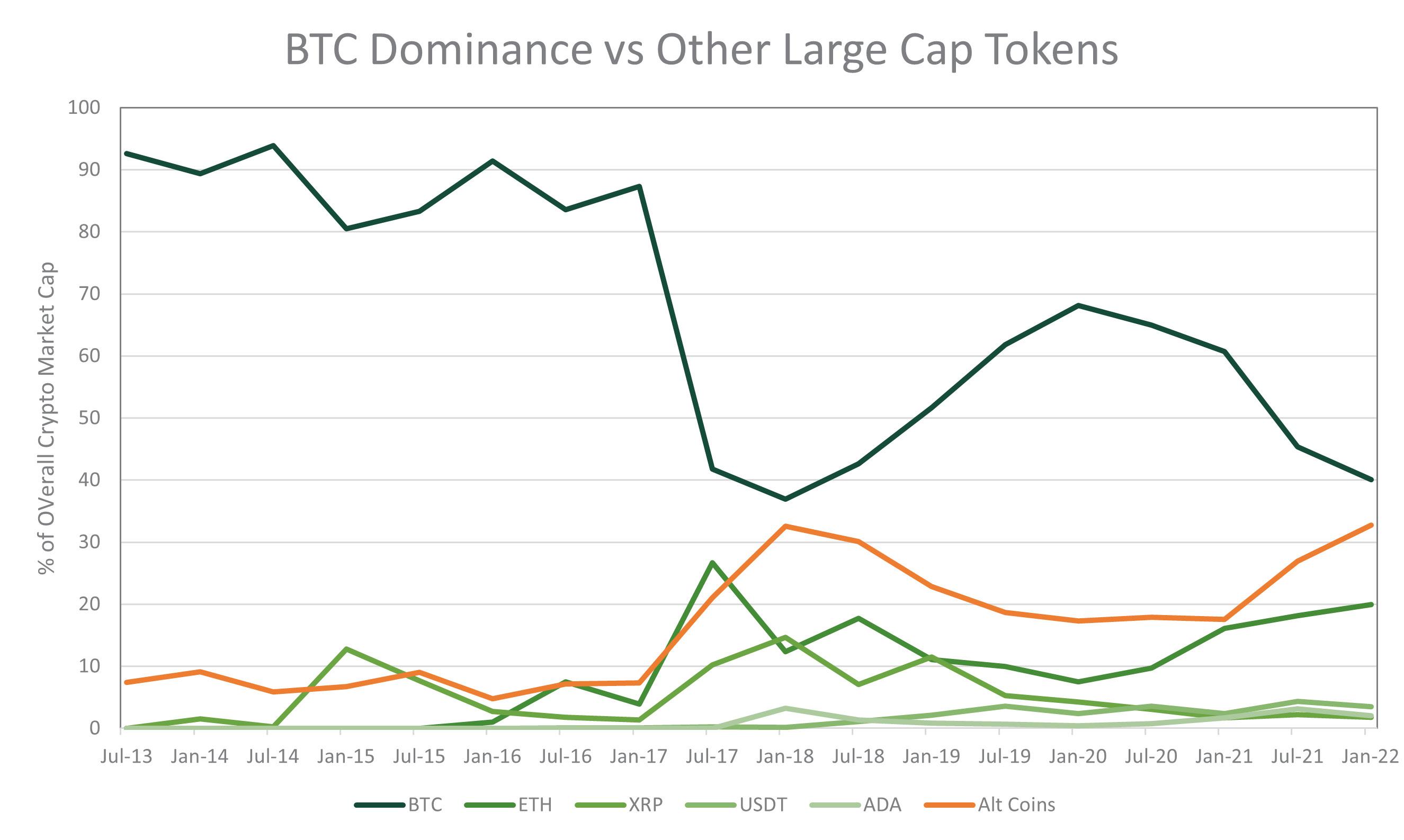
ICO’S
An ICO stands for initial coin offering. ICOs are the cryptocurrency equivalent of an IPO as they are a method to raise capital for cryptocurrency projects in a blockchain environment. ICO exchange platforms allow investors to receive unique cryptocurrency rewards in exchange for monetary investment in the project. This function gives investors exclusive access to features of a project run by the creators. Thus, similar to IPOs, ICOs allow for the funding of open-source projects that would otherwise be difficult to fund with traditional business structures. Most ICOs are issued on dApp platforms after they declare intentions to organize an ICO by publishing a "white paper." The white paper explains the entire blockchain project, its goals, its roadmap, the
amount of capital it needs to raise via the ICO, and other necessary information to help investors decide if they want to participate. Although investors can make significant profits from ICOs, the U.S. crypto market lacks regulation, making them extremely risky.
NFT (NON-FUNGIBLE TOKEN)
WHAT IS AN NFT?
Non-fungible tokens (NFTs) are unique and secure digital assets registered on a blockchain. NFTs are non-fungible, which means they cannot be altered or replicated due to their unique identification code. NFTs as digital assets are creating emerging applications for the ownership transfer of unique and original digital assets such as art, music, real estate, and videos.
HOW DOES IT WORK?
NFTs run on a blockchain, similar to traditional cryptocurrencies such as Ethereum, where anyone can see transactions, making it easy to verify and track ownership of assets. However, NFTs differ because they are being used to represent unique real-world objects such as real estate and art via a process known as tokenization. The concept of tokenizing
16
a real-world object with digital assets has promising features with the potential to change multiple industries. For example, an artist can connect with his audience by selling his music via NFTs. This would allow a direct relationship between buyers and sellers, and because NFTs are non-fungible and have their transaction data stored in a blockchain, it would prevent the artist's music from being replicated or stolen. A similar concept can also be applied in the art or real estate industries, where precious artworks or real estate properties could be tokenized into NFTs to prevent replication and allow for transparent transaction data.
MEME COINS
Meme Coins are cryptocurrencies inspired by memes or jokes and they have become astonishingly popular within the cryptocurrency market in recent years. A good example is Shiba Inu which went viral after Tesla founder Elon Musk tweeted a picture of his dog. A similar instance occurred with Dogecoin when the coin rose in value by 600% in one week after Musk and other influencers and celebrities promoted Dogecoin on Twitter. Incredibly, in May 2021, Dogecoin peaked at a market cap of almost $90 billion, twice the market cap of Ford Motors. Since then, Dogecoin has decreased in value by over 90%. Meme coins are extremely volatile and should not be taken seriously as a legitimate investment opportunity.
DAO - DECENTRALIZED AUTONOMOUS ORGANIZATION
DEFINITION
“A DAO is a blockchain-based system that enables people to coordinate and govern themselves mediated by a set of selfexecuting rules deployed on a public blockchain, and whose governance is decentralized” (Samer Hassan, Primavera de Filippi, 2021)

A Decentralized Autonomous Organization is a blockchainbased technology that enables the functions of a DAO to operate independently from its user's influence. Applications of DAO technology are most likely to appear in upcoming years in combination with internet-of-things devices and the metaverse. The Bitcoin blockchain is the most basic interpretation of a DAO because the Bitcoin network scales through fully transparent modifications suggested by the community. However, this interpretation has evolved with the development and broad implementation of Proof-of-Stake consensus mechanisms. Modern interpretations describe a DAO as a service-oriented network on a blockchain governed through either a native or foreign governance token. Staking tokens in the network enables holders to claim profits if applicable and covers the network's expenses if needed. Smart contracts set the rules for the execution and termination of the service offered, meaning that if pre-set conditions are met, then DAO rules are enforced without human confirmation.
ANALOGY
Imagine ordering pizza from your local pizza chain without human involvement in the delivery process as a self-driving vehicle delivers your pizza. Once the order is received, a DAO will track the contents of your order and the time until delivery. The DAO then charges the customer automatically based on the amount of pizza ordered and the distance covered. In case
17
of an unusual delay, it automatically issues a discount after delivery, based on predetermined dollar amounts contingent on predetermined discount rates per unit time. This process eliminates the need to negotiate with the delivery company in case of a delay and automatically uses internal data to charge the appropriate amount for the delivery.

DECENTRALIZED FINANCE (DEFI)
DEFI VS. CENTRALIZED FINANCE
The financial world currently relies on centralized intermediaries who specialize in financial services. These intermediaries provide services to a variety of market participants, and in its most basic form, financial intermediaries connect buyers and sellers. The core idea of DeFi can be described as the elimination of traditional intermediaries in exchange for automated open-source systems connecting buyers and sellers using a prespecified set of rules generally outlined in smart contracts. DApps typically drive DeFi systems to operate token swap exchanges such as Uniswap or gaming virtual realities such as Decentraland.
METAVERSE
“The Metaverse is the post-reality universe, a perpetual and persistent multiuser environment merging physical reality with digital virtuality. It is based on the convergence of technologies that enable multisensory interactions with virtual environments, digital objects and people such as virtual reality (VR) and augmented reality (AR).” Mystakidis, S. Metaverse. Encyclopedia 2022, 2, 486-497.
Functions of the metaverse range from gaming and entertainment to building a social life and creating a learning environment. The range of potential applications of a VR- and AR-based universe is immense, causing many tech companies to shift attention from Web 2.0 projects to metaverse projects.
BLOCKCHAIN APPLICATION
Blockchain technology provides a secure way of certifying ownership of digital assets within digital virtuality. The gaming industry has been selling digital assets through license agreements for many years, but ownership via individual hashes provides a clearer definition of property rights in a digital reality. Also, the concept of scarcity within a digital reality is still in its infant stage, which begs the question: Does rational human behavior even allow people to commit their social life to digital reality, or are people’s natural urges going to put a ceiling on the metaverse’s adoption? Is the metaverse here to stay? A psychological approach:
For this analysis, Freud’s “pleasure principles” suggest that creating an alternative reality has to come with an overload of artificial rewards to stimulate a human’s eros. A metaverse can only be adopted if rewards from entering the metaverse exceed the physical world’s pleasures, such that it will engage the user to frequently return. Also, from an economic perspective, the inflationary use of monetary rewards would pose a major challenge regarding the store of value in the metaverse.
“Technology that’s built around people, and how we actually experience that world and interact with each other, that’s what the metaverse is all about..” (Mark Zuckerberg)
18
Thanatos, the drive for power, is another concept referencing Freud that poses a significant challenge for metaverse adoption, as the entire vision for a metaverse interferes with human nature. Early adopters of the metaverse naturally strive for power within the new reality, limiting the power of late adopters, who are likely to be left behind. Once matured, only a fraction of early and aggressive adopters may be able to truly reap the benefits of the metaverse. Thus, contradicting the metaverse's underlying vision.
LIQUIDITY POOLS
DEFINITION
“A liquidity pool is a collection of funds locked in a smart contract. Liquidity pools are used to facilitate decentralized trading, lending, and many more functions.” (Binance Academy)
Liquidity pools are the core of any decentralized exchange’s (DEX) operational processes. Since DEXes do not use a clearinghouse to facilitate trades between willing buyers and sellers, liquidity pools are a decentralized alternative. Without the need for human interaction, users can lock their funds into a smart-contract-driven liquidity pool, which the DEX lends out if needed.
Liquidity pools are a pool of two assets that operate on the premise that the value of coins in the pool consistently remains at an equal ratio. For this to occur, algorithms known as Automated Market Makers (AMM) determine the price of coins being transferred via the liquidity pool. Trading on an AMM platform differs from trading on traditional blockchains because transactions are not made peer-to-peer (P2P). Instead, the user interacts with an automated algorithm that assigns each digital asset a fair market value based on economic forces. Essentially, there does NOT need to be a seller in the market. If a user wants to make a transaction on an AMM platform, as long as the pool has enough liquidity, the transaction can occur at fair value. Liquidity is provided by other users staking their

digital assets, and DEXes incentivize liquidity providers to stake their digital assets by giving Annual Percentage Yields (APY) in return for liquidity. Thus, A DEX guarantees its liquidity to the exchange by paying annual percentage yields derived from a network’s transaction fees to the network’s staking community.
AUTOMATED MARKET MAKER
Automated Market Makers (AMMs) are the algorithms that support liquidity pools and determine the price of coins to allow for permissionless and automatic trading processes. The most common form of an AMM is the common product AMM. An analogy is the best method to communicate the role of the common product AMM ...
Imagine you and your friend decide to establish a trade service in milk and eggs. The milk and eggs in the liquidity pool are kept in a refrigerator that initially holds 50 cups of milk and 50 eggs, each worth $1. Therefore, the total value of the refrigerator is $100.
When someone asks to trade 10 eggs for cups of milk, you need to decide how many cups to give them. Remember, you will have 60 eggs after the trade; therefore, supply has increased, and the value of eggs in the pool will fall.
The constant product method operates according to the simple formula: x×y=k.
x = number of cups of milk y = the number of eggs
Initially, when we had 50 cups of milk and 50 eggs: k=50×50=2500
19
Now we have 60 eggs, but according to the constant product method, we must retain the constant value of k.
x×60=2500
x = 2500 / 60
Therefore, the number of cups of milk that must be in the refrigerator after the trade is 41.67. Your friend receives approximately 8 cups of milk for the 10 eggs, and the trade is complete. Now, we have 60 eggs and 41.67 cups of milk in the refrigerator, but remember, the key principle of a liquidity pool is to retain a 50:50 split in the value of milk and eggs. So, to encourage economic forces, we reflect changes in supply in the price.
The price of Milk= $50/41.67 = $1.20
The price of Eggs = $50/60 = $0.83
Naturally, with the price of eggs lower, people will buy the 10 extra eggs at a discount, and the refrigerator will return to equilibrium. Of course, to return to cryptocurrency, the refrigerator is the liquidity pool, and the milk and eggs are two tokens being traded. Liquidity pools are desirable, as they remove the need for traditional clearing houses and their associated problems. Also, the more value in a liquidity pool, the more stable the price of the tokens. Therefore, decentralized exchanges reward liquidity providers — cryptocurrency owners who add their tokens to the liquidity pool — with annual percentage yields, funded by the DEXes transaction fees. The key concept to remember is that a liquidity pool aims to retain the 50:50 ratio of value within the pool, so as long as sufficient APYs incentivize sufficient liquidity, then the liquidity pool can remain effective.
“risk-free” cryptocurrency investment strategies within crypto markets. To properly understand the opportunities available to generate APY from cryptocurrencies, it is critical to understand the risks involved in yield farming, namely impermanent losses.
YIELD FARMING & ANNUAL PERCENTAGE YIELD (APY)
Annual Percentage Yield (APY) is a financial term that defines return on investment, accounting for the effect of compound interest. APY relates to the returns generated from passive cryptocurrency investment through staking in liquidity pools and other yield farming methods.
Yield farming is the term denoted to investors who seek
IMPERMANENT LOSS
Impermanent losses describe the opportunity costs of providing liquidity to a liquidity pool compared to simply holding the staked tokens. As the volatility of the crypto assets in the liquidity pool increases, so does the risk of experiencing impermanent losses. Assuming two crypto assets are staked at a 50:50 ratio and carry an identical dollar value, a 2X price appreciation in one of the assets (ceteris paribus) would result in a 5.72% impermanent loss because the market value of both assets within the liquidity pool must be equal. Thus, staking crypto assets in a liquidity pool does NOT protect against sudden price drops. Binance Academy has outlined approximate impermanent losses for changes in the price of one crypto asset for a liquidity pool consisting of two crypto assets.
Price Change Resultant Impermanent Loss
25% Increase 0.6% Loss
50% Increase 2.0% Loss
75% Increase 3.8% Loss
2X Increase 5.7% Loss
3X Increase 13.4% Loss
4X Increase 20.0% Loss
5X Increase 25.5% Loss
20

21


WEB 3.0 DECENTRALIZED CURRENCY SMART CONTRACTS DAOS NFTS BLOCKCHAIN APPLICATIONS 23
BLOCKCHAIN APPLICATIONS
The emerging applications of blockchains across many industries are becoming increasingly apparent. This chapter explores some of the most promising applications many global companies are already seeking to incorporate into their business operations. Like a venture capitalist seeking the newest revolutionary startup, crypto investors can find high returns in the crypto space by focusing on these applications and investing in the cryptocurrencies funding applicable blockchain projects.
WEB 3.0
The term Web 3.0 was coined in 2014 by Gavin Wood, cofounder of Ethereum and Polkadot. To better understand the idea of Web 3.0, it is first necessary to understand Web 1.0 and the subsequent Web 2.0, which are seen as the first two major phases of the evolution of the internet.
Web 1.0 featured read-only content, where users were merely consumers. The internet consisted of static pages without interaction or input from the users. Web 2.0 saw increased interactivity between users and the internet, allowing users to interact with both webpages and fellow internet users. The interactivity between the internet and users ushered in the dawn of targeted marketing, using the data knowingly or unknowingly provided by users to display relevant advertisements to users on the platform. This new age of targeted advertising and reduced privacy saw users evolve from consumers to products, whose data is sold to help companies improve marketing and sales. It is this evolution Web 3.0 may have the capability to address.
This graphic from Fabric Ventures outlines the progression of the internet to the current day, including the blockchain

developments of Bitcoin and Ethereum. Fabric Ventures defines Web 3.0 as the development of a “composable humancentric and privacy-preserving computing fabric for the next wave of the web.” This definition highlights two of the key points that differentiate Web 3.0 from the current internet, creating an internet that is user-centric and protects user data. The client-server model that is the core of Web 2.0 is inherently centralized, with all data pertaining to one company stored on a centralized server. This model exposes users to the risk of server failure or data theft, requiring significantly high levels of trust in companies such as Amazon or Facebook to ensure data is kept safe. Vulnerability to data theft or misuse has been highlighted in incidents involving LinkedIn, when 700 million users had their data offered for sale online, or the Facebook’s data incident with Cambridge Analytica. A further challenge to the Web 2.0 model means users can only use a company’s service if the company gives the user permission.
In response to the privacy and centralization problems faced by the Web 2.0 era, Web 3.0 seeks to develop an internet based on greater decentralization, permissionless use and increased user connectivity. Blockchain is seen as the technology driving the development of Web 3.0, facilitating smart contracts, decentralized data storage, and increased use of DAOs
24
The potential for blockchain technology to reinvent a multitude of industries and professions is imminent and real.

” 25
to support and manage businesses. Charles Silver, Forbes Councils Member, believes “decentralized infrastructure and application platforms will displace centralized tech giants, and individuals will be able to rightfully own their data.” Thus, Web 3.0 seeks to tilt the scales of power away from corporations and back toward the individual.
While Web 3.0 holds promise in overcoming the issues of Web 2.0, Web 3.0 faces significant challenges to widespread adoption. The decentralized nature of data storage means the network is slower, and considerable upskilling is required for Web 3.0 to become mainstream. This has led to skepticism from influential voices in the technology space, such as Jack Dorsey and Elon Musk, who has said Web 3.0 is “more marketing than reality.”
Despite the clear challenges Web 3.0 faces, it appears certain that blockchain technology will become increasingly integrated into the internet, creating either a new third-generation internet or a vastly modified Web 2.0.
The applications of Web 3.0 also extend to the development of digital identities, with Atala Prism rolling out a decentralized digital identity protocol to support verifiable records without the need for a centralized database. A digital identity is a digital representation of the physical forms of identification often carried around, such as driver’s licenses and bank cards. The digital identity developed by Atala Prism would create a personally owned, verifiable digital identity that would also include features such as educational records that could be shared with a potential employer.
Atala Prism is collaborating with Input Output and the Ethiopian Ministry of Education to support the delivery of digital identities to students and teachers across Ethiopia. The program will extend to the broader population to facilitate digital identities, aiming to include additional information such as credit history to support loan applications. Therefore, the use of blockchain technology has the potential to generate meaningful change in addressing common difficulties of identity verification.

Social networks such as Secretum offer decentralized and encrypted messaging, allowing users to connect without an email address or phone number. Interestingly, Secretum is a dApp built on the Solana network, indicating the utility of the SOL cryptocurrency and the Solana network. This application alone demonstrates the potential for blockchain technologies to decrease centralization and improve user privacy while, in a negative sense, increasing the difficulty of tracing illegal activity. Similar Web 3.0 alternatives include DTube, a video sharing platform, and Steemit, a decentralized social blogging platform.

DECENTRALIZED CURRENCY
Use as a decentralized currency is one of the blockchain applications that forms a key pillar for Web 3.0. Even in the past few months, at the time of writing, the value of a borderless digital currency has become apparent during the early stages of the Russia-Ukraine conflict. At a time when the traditional, centralized banking institutions in Ukraine had frozen the transfer of assets, $54 million of cryptocurrencies was rapidly transferred to the Ukrainian government.
Decentralized currencies allow users to perform financial transactions without a third-party intermediary. Information relating to the currency transactions is publicly available and stored on the blockchain of that currency. By using distributed
26
ledger technology (DLT), the records of all transactions can be stored on a public ledger and accessed by individuals or nodes. While BTC is the most well-known decentralized currency, several alternatives may be adopted into mainstream financial transactions.
Currently, BTC is the cryptocurrency most widely accepted for payment, but the adoption of other cryptocurrencies for payment is commencing. In the United States, Paypal accepts Bitcoin, Bitcoin Cash, Litecoin and Ethereum as payment methods. The streaming platform Twitch accepts a broader range of coins for payment, including USDC and XRP. Pavilion Hotels & Resorts accepts more than 40 coins as suitable payment, while the travel agency Expedia also accepts payment in cryptocurrency.
While the uptake for the widespread use of cryptocurrencies for mainstream payments has been slow, there is a steady progression toward adoption. As decentralization becomes increasingly attractive, decentralized currencies offer a potential alternative to fiat currency with greater transaction speed and the removal of powerful institutions acting as financial intermediaries.
RealT uses blockchain technology and smart contracts to offer fractional ownership of real estate. RealT uses tokenization, a process where real assets can be divided into small portions, and tokens are created to represent each of the portions. Investors from around the world have the opportunity to invest in the U.S. housing market with token prices as low as $50 USD. Where real estate investing is traditionally accessible to only the wealthy, tokenizing real estate allows investors to enter the market with much less capital than a traditional real estate investment. As explained by RealT, tokenizing assets brings robustness, increased accessibility and immutability to real estate contracts.
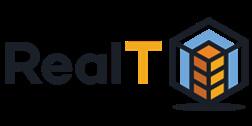
SolidBlock is also an asset tokenization company that operates similarly to RealT on a smaller scale. SolidBlock is currently offering or in the process of acquiring properties in London, Phuket and across America.
SMART CONTRACTS
Of the many applications that blockchain technology offers, smart contracts may offer the broadest-use cases. From insurance to rental agreements, smart contracts have the potential to truly revolutionize methods that have remained unchanged for decades. Smart contracts have a wide range of applications in the real estate and financial sector, supporting lending and borrowing on a platform that is available 24/7 and at a lower cost than traditional financial services. The following applications utilize smart contracts in the real estate and finance sector.
Similar to the real estate industry, decentralized finance (DeFi) apps can improve the ease of access to financial services. Beyond improvements delivered by blockchain identity verification systems such as Atala Prism, DeFi apps powered by smart contracts simplify lending and borrowing. Traditional loans require users to go to a bank, provide identity verification and wait on the bank to determine if a loan will be paid out. By using decentralized finance, loans are accessible with greater speed and without the need for financial intermediaries.
While several blockchain-powered lending platforms are available online, smart contracts can also improve the way traditional financial services are managed by reducing the time required to monitor and enforce financial agreements. However, the extent to which smart contracts will be integrated into the traditional finance sector remains undetermined and is contingent upon the broader adoption of blockchain technology across multiple industries.
27
DAOs
DAOs have a wide range of applications, from use in corporate structures to philanthropy or insurance. In the context of a business, the native token of a company DAO will increase in value if the company succeeds. Therefore, the employees who receive native tokens as compensation are incentivized to perform. DAOs have potential-use cases in setting up company structures to reduce overheads and streamline processes by applying decentralized protocols across various industries.
A notable example of the use of DAOs to support charities is the Big Green DAO, founded by the brother of Elon Musk, Kimbal Musk. The Big Green DAO uses the decentralized governance unique to DAOs to determine the distribution of grant funding. The rationale behind the DAO, as explained by Musk, is that charities or insiders within the philanthropic often will know which charities are the best to receive funding. Therefore, a DAO has the ability to circumvent the often timeconsuming and bureaucratic grant processes and streamline funding to organizations that will do effective work.

A further application for DAOs is in the insurance industry. While there are yet to be major inroads made in pursuing a DAO-supported insurance company, Dynamis is attempting to establish a DAO model for redundancy insurance that removes the need for traditional insurance brokers.
NFTs
A further promising application for blockchain technology is the rapidly expanding NFT market. NFTs provide exclusive ownership rights for a digital asset. Currently, the NFT phenomenon revolves mainly around digital art, such as items from the Bored Ape NFT collection that have sold for millions of dollars. However, the use cases for NFTs extend beyond digital art, with several other applications looming to disrupt existing technology subindustries.
For example, universities could issue NFTs as diplomas for graduating students to show their certification. Hospitals could also use NFTs by issuing them for birth certificates of newborns, as well as for keeping medical history records. Similarly, NFTs could be used as passports, ID cards and driver’s licenses because of their non-fungible and immutable characteristics. Another central application of NFTs is to solve current supply chain problems by using their transparent data flow properties to track products in the supply chain between shipping and delivery. While NFTs are yet to be integrated into these industries in a meaningful way, there is potential for wide-scale adoption. Essentially, the list of real-world opportunities for NFT adoption is extensive and still growing fast.

28
Propy is a European-based startup that offers real estate for sale in the form of NFTs. Propy was the first company to complete an NFT property sale. Ownership of the NFT for a particular property gives access to all the necessary ownership documentation for that property, significantly simplifying the property-buying process.
Blockchain technology, while still very much an emergent technology, is already finding its niche in multiple applications across various industries. Whether through smart contracts, decentralized currency or NFTs, blockchain technology has the potential to disrupt traditional methods by creating faster and decentralized processes. While the future of cryptocurrency is unclear, there is no doubt the adoption of blockchain technology will continue to increase, and it is conceivable that rises in cryptocurrency prices will correlate to increases in the adoption of Web 3.0 and blockchain applications.


29

TRADING

LONG-ONLY FUNDAMENTAL ANALYSIS SHORT BITCOIN DOMINANCE YIELD FARMING GLOBAL RISK FACTORS POTENTIAL
STRATEGIES 31
LONG-ONLY FUNDAMENTAL ANALYSIS
Despite crypto assets experiencing more volatility and risk than any traditional asset class, detailed fundamental analysis for cryptocurrencies can yield unprecedented returns. With any blockchain start-up being able to launch an ICO, retail and institutional investors can gain exposure to those organizations through investment in their token. Like investments in early-stage private equities, the blockchain industry (as long as it remains unsaturated) creates a marketplace for high-risk investments with large potential upside. Analyzing tokens with regard to utility, tokenomics and ESG factors sets promising projects apart from scams and unpropitious tokens. We propose a long-only fundamental portfolio based on weightings of the following blockchain subindustries.
Crypto Industry Allocations
Crpyto Industry Allocations
ALTERNATIVE INFRASTRUCTURE (40%) –AVAX, DOT, SOL, ADA, ONE, NEAR, ATOM
Market Movers Alternative Infrastructure NFT & Metaverse Defensive dApps & Governance
MARKET MOVERS (25%)ETH, XRP
Despite the highly volatile nature of cryptocurrencies, the leading market movers BTC and ETH have proven to be less volatile than other altcoins in the long run. With “Short-BTC Dominance” being one of the trading strategies outlined in this guide, ETH and XRP remain the other significant market movers by market cap. Many projects are layered on the Ethereum blockchain or are compatible with the network’s infrastructure, while Ripple has proven utility and strength in longevity within the crypto market. Therefore, an allocation of 25% in market movers is recommended for long-only fundamental investment.
With Ethereum conquering the DeFi space at earlier stages than competing blockchains, plenty of market share is up for grabs for projects with competent management and high adoption potential. Projects such as Avalanche, Polkadot and Solana represent enormous potential through superior scaling solutions compared to Ethereum. Despite the ease of accessing the existing Ethereum infrastructure being one of the network’s key competitive advantages, it can be expected this advantage will diminish as other blockchains rapidly adopt decentralized applications.
NFTs & METAVERSE GAMING ADOPTION (10%) –
MANA, SAND, AXS
Few industries have seen capital inflows like metaverserelated blockchain technology in Q4 of 2021. In response to losses caused by Facebook’s rebranding to “Meta” on October 28, equity investors did not estimate risk compensation to be appropriate due to the uncertainty surrounding the potentially revolutionary technology. Since October 2021, the attention given to metaverse technology has boosted the demand for respective tokens in the same time frame. The hype has since diminished, with highly valued tokens such as MANA, SAND
32
PORTFOLIO ALLOCATION TABLE
Solana
Cardano (ADA)
NEAR Protocol (NEAR)
Cosmos (ATOM)
Harmony (ONE)
and AXS dropping 50% or more from their all-time highs. If the adoptions of the metaverse and NFTs can make considerable progress, significant gains for token holders are a possibility, while the risk of substantial losses remains. Knowing the large swings within the industry, a weighting of 10% in NFT and metaverse tokens is recommended.
DEFENSIVE PORTFOLIO ALLOCATION (15%)USDC, DAI, PAXG
The highly volatile nature of cryptocurrencies presents a significant challenge from a portfolio management standpoint. The backbone of a well-diversified cryptocurrency portfolio must be capital allocation to stablecoins or tokens that hedge against crypto market risk. This portfolio’s thesis supports the rise of DeFi while moving away from centralization, which is applied through the use of crypto-collateralized and algorithmically-stabilized stablecoins instead of fiatcollateralization. An exception from this trend is recommended when using PAXG, an asset-backed token representing the value of physical gold, adding another layer of inflation hedging to the portfolio.
Maker (MKR)
DAPPS & DEFI GOVERNANCE (10%) - MATIC, UNI, AAVE, MKR
The “dApps & governance” segment comprises large and small-cap tokens identified to have exceptional utility and scalability potential. The dApps represented in this sector must be built on one of the blockchains placed in “Market Movers” or “Alternative Infrastructure.” Scalability solutions for existing blockchains such as MATIC are recommended as the core of this segment, while DEX governance tokens should be selected based on high growth potential, such as the AAVE token. Risky small-cap tokens with a promising vision can be incorporated at a lower weighting portion.
Market Movers 25% Alternative Infrastructure 40% NFT & Metaverse 10% Defensive Portfolio Allocation 15% dApps & DeFi Governance 10% Ethereum (ETH) 18% Avalanche (AVAX) 10% Decentraland (MANA) 4% USD Coin (USDC) 7% Polygon (MATIC) 4% Ripple (XRP) 7% Polkadot (DOT) 9% The Sandbox (SAND) 3% Dai (DAI) 5% Uniswap (UNI) 3%
(SOL) 8% Axie Infinity (AXS) 3% PAX Gold (PAXG) 3% Aave (AAVE) 2%
5%
1%
4%
2%
2% 33
SHORT BITCOIN DOMINANCE
Bitcoin Dominance is the term used to describe the control Bitcoin has over the cryptocurrency market. As of January 1, 2022, the total investment in Bitcoin represented 40.04% of the entire crypto market. Although this was a significant portion of the then $2.19 trillion asset class, it is only a fragment of what it once was. In January 2016, Bitcoin represented over 91% of the overall crypto market, and basic trend analysis indicates it will continue to decline based on multiple fundamental factors.
We suggest Bitcoin’s dominance within the crypto asset class is primarily due to its status as a first market mover. Bitcoin was the first decentralized currency, the first and only to break $10k and $50k price barriers, and has held the title for the highest market cap token for the entire existence of cryptocurrency. However, this significant first market mover advantage will decline over the coming years. Bitcoin has slower transaction speeds, operates on the slow and energy-inefficient proof-ofwork protocol, and most importantly, it has no sustainable competitive advantage.
Bitcoin’s only real utility is its potential use as a decentralized global currency. However, this is relatively insignificant compared to the competitive advantage of other large-cap tokens such as ETH, SOL and AVAX, which have created their own entire blockchain ecosystems. Thousands of dApps are being built on the major ecosystems, and multinational technology companies, including Google and PayPal, are adopting the technology presented by major blockchains.
Many of the largest blockchain tokens also have teams of highly skilled blockchain engineers and strategists constantly improving their projects and searching for growth opportunities in the emerging market. Therefore, Bitcoin’s lack of growth potential indicates the token is only valuable due to its first-mover advantage and presents no sufficient reason to grow.
Bitcoin’s lack of growth and progress in the emerging technology industry is comparable to the mobile phone industry boom in the early 2000s. Motorola and Nokia dominated the mobile phone market but failed due to their lack of innovation and product differentiation. History repeated itself in 2008 when Blackberry collapsed due to its lack of continual innovation. However, Apple has managed to overcome this challenge and has dominated the smartphone industry with its continual drive to improve its products and be leaders in innovation. Many industry professionals credit Apple’s longevity in the rapidly developing technology market to its continual drive to always improve and never settle on a good product. Making the assertion that the blockchain industry is similar to the mobile phone industry during the 2000s, we suggest blockchains that do not continually look for improvement and growth will collapse in the upcoming years. Therefore, short-selling Bitcoin dominance and investing with a long position in major altcoins presents itself as a profitable and hedged market-neutral strategy.
0% 10% 20% 30% 40% 50% 60% 70% 80% 90% 100% $$500,000 $1,000,000 $1,500,000 $2,000,000 $2,500,000 Jul-13 Jan-14 Jul-14 Jan-15 Jul-15 Jan-16 Jul-16 Jan-17 Jul-17 Jan-18 Jul-18 Jan-19 Jul-19 Jan-20 Jul-20 Jan-21 Jul-21 Jan-22 BTC Dominance (%) Overall Crypto Market Cap ($M) Crypto Market Capvs BTC Dominance Market Cap (Million) BTC Dominance Crypto Market Cap vs BTC Dominance 34
An analysis of a “Short-BTC Dominance” trading strategy confirms the profitability of this trading proposal. A simulation was conducted to evaluate the success or failure of a Short-BTC Dominance strategy between October 1, 2020, and March 31, 2022. The simulation involved constructing a hypothetical market-neutral portfolio with a short position in BTC and a long position in 10-12 selected altcoins. Altcoins were chosen based on criteria of high correlation to BTC and positions of high market cap status that indicate the unlikeliness of the asset failing. The 10-12 altcoins were reevaluated and reweighted every six weeks based on performance over the previous sixweek period. An individual token’s weight in the portfolio was minimized at 2% and maximized at 15%. The following graphic shows how the Short-BTC Dominance portfolio compared to a long-only investment in Bitcoin - R(b), as well as a long-only investment in the same altcoin portfolio - R(p), based on a hypothetical $10,000 initial investment.
The results of the strategy backtesting display a total return potential of approximately 150% over the 18-month time frame, with a geomean daily return of 0.17%. Although the effectiveness of this strategy may be questionable, considering long positions in both BTC and the altcoin portfolio outperformed the “Short-BTC Dominance” portfolio; risk aversion and mitigating “bubble-risk” drive this market-neutral
strategy. Although we acknowledge the outperformance of the long-only portfolios, the standard deviation of returns for the market-neutral strategy was significantly lower than the two long-only positions.
Moreover, similar to the line chart of a low beta stock, the strategy performs worse during expansionary periods, but has significantly limited downside whenever the market contracts as a whole. For example, in the Bitcoin boom during the early months of 2021, the Short-BTC Dominance portfolio significantly underperformed market returns, but during volatile periods of late 2021, the Short-BTC Dominance strategy saw steadier growth returns than traditional long-only positions.
Therefore, we believe this market-neutral strategy that short sells the future of Bitcoin Dominance is a profitable opportunity within the cryptocurrency space. Bitcoin is highly unlikely to maintain its dominance over the crypto market due to its lack of growth potential and competitive advantage. Therefore as the crypto market continues to grow and investors seek high rewards with higher risk, we predict using a market-neutral strategy that short sells BTC will generate highly profitable hedged returns.
Week
$100,000.00
$90,000.00
$80,000.00
$70,000.00
$60,000.00
$50,000.00
$40,000.00
$30,000.00
$20,000.00
$10,000.00
$-
1-Oct-20 1-Nov-20 1-Dec-20 1-Jan-21 1-Feb-21 1-Mar-21 1-Apr-21 1-May-21 1-Jun-21 1-Jul-21 1-Aug-21 1-Sep-21 1-Oct-21 1-Nov-21 1-Dec-21 1-Jan-22 1-Feb-22 1-Mar-22 Value of Portfolio ($) Short- BTC Dominance 6
Reweighting Short-BTC Dominance 6-Week Reweighting R(b) R(p) 35
YIELD FARMING
CRYPTO YIELDS: A VALUE INVESTMENT OR GLORIFIED JUNK BONDS?
Yield farming is the process of investing in multiple cryptocurrency liquidity pool protocols and compounding annual percentage yields (APYs). In 2020, yield farming netted DeFi pioneers immense profits from lending and providing liquidity to decentralized protocols. With some large dApps providing more than 100% APYs to lenders, the reward to lenders easily exceeded the risk. However, the DeFi landscape has changed a lot in a short time. As collateralization on the major networks has risen, the borrowing activity and trading volume have not. This caused the major liquidity pools to be oversupplied, decreasing the lending yields.
Alternatively, centralized lending platforms like Celsius and Nexo provide similar services. Unlike most DeFi lending platforms, centralized lending platforms do not just rely on borrowing and lending to ccreate an equilibrium interest rate, as they operate by actively lending out fund to other financial institutions. Robust demand from institutions causes APYs on centralized lending platforms to be more attractive during a DeFi drought, in which DeFi borrowing activity cannot keep up with lending volume.
APY STRATEGY
Passive investors with no desire to sell their crypto assets for a foreseeable time frame are highly encouraged to lend out that crypto using a trustworthy lending protocol. Even low yields can substantially enhance a passive portfolio’s performance in both bull and bear markets. An active yield farming strategy requires much more flexibility and thorough research regarding a lending platform’s risks, yields and pool offerings,
presenting a significant challenge in the constantly changing crypto world. It is also important to note that a lender has exposure to all cryptocurrencies within the liquidity pool. Therefore, an investor who is avoiding exposure to Tether is advised not to stake Wrapped BTC in the “tricrypto2” liquidity pool on Curve Finance, as the given pool is composed of wBTC, WETH and USDT.
Additionally, one must monitor the relationship between borrowing and lending activity. As many pools are overcollateralized, they do not provide attractive yields. Newer pools and emerging protocols typically provide higher yields, as the network compensates lenders with higher returns to meet borrowing demand. Emerging DeFi networks built on trustworthy blockchains that have been audited through multiple independent smart contract auditors offer the highest yields for low risks.
RECOMMENDATION
We recommend lending crypto-assets into liquidity pools on established platforms such as Curve or Aave. In the everchanging crypto ecosystem, locking up tokens for an extended period poses a significant risk for investors. One must monitor the borrowing and lending activity and ensure that borrowing and lending rates match borrowing and lending activity on that particular platform. After the collapse of Terra, generating interest from lending out stablecoins is not recommended because fiat currencies offer similar returns at lower risk. Instead, lending and staking rewards should generally be generated from promising crypto-projects with tokens already being held in a portfolio based on fundamental analysis.
36

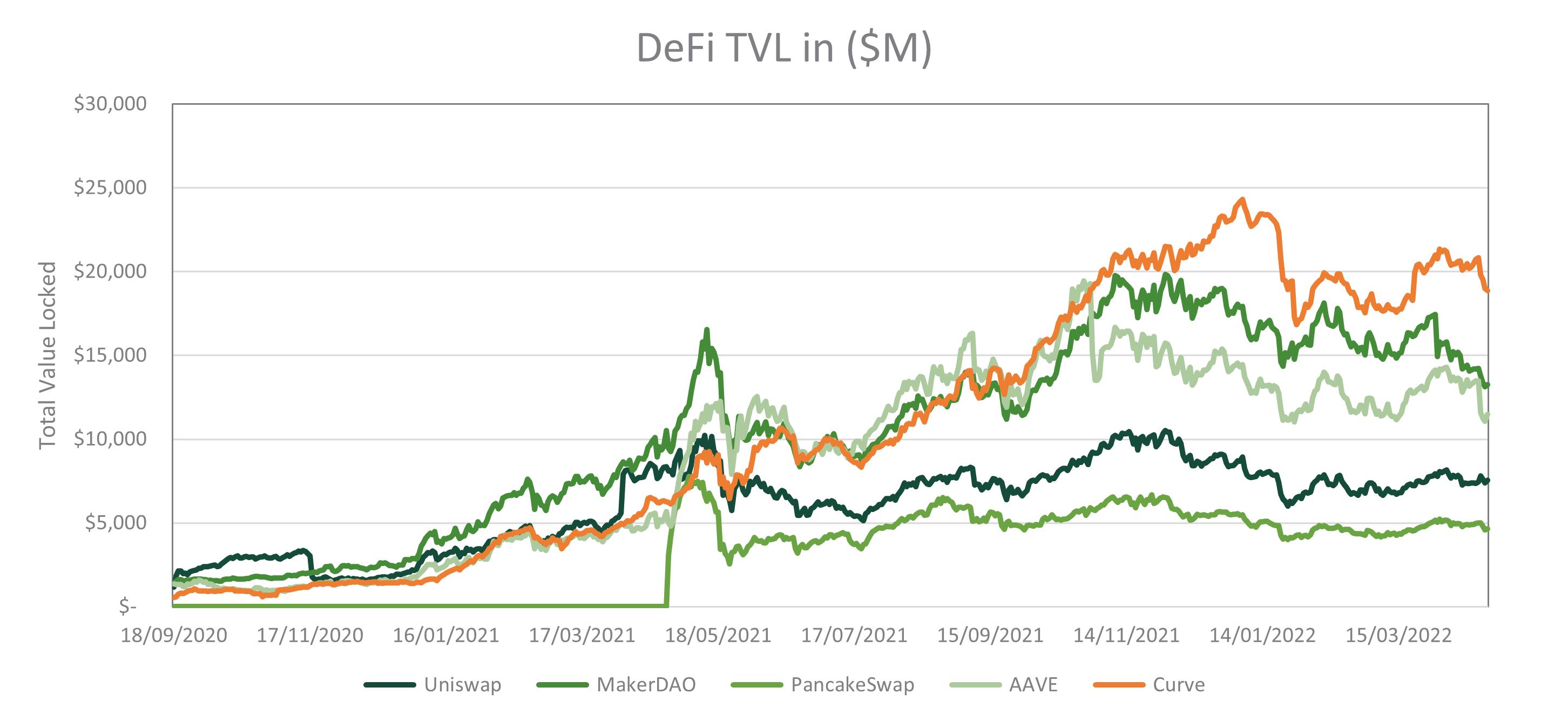
GLOBAL RISK FACTORS
TETHER RISK
Tether is a fiat-backed stablecoin, and as of April 2022, it is the third-largest cryptocurrency by market cap. Due to its nature as a fiat-collateralized stablecoin, each USDT token must be backed by one U.S. Dollar in the firm’s reserve to guarantee solvency if large sums are withdrawn at once. However, in the past Tether has declined independent audits when rumors spread about Tether minting USDT without having the matching amount of currency in reserves. The management team’s ties to the Bitfinex exchange are also problematic, as Bitfinex’s founders face allegations regarding multiple acts of cybercrimes including participation in Ponzi schemes, software piracy and money laundering. If allegations about Tether minting USDT without proper backing of the U.S. Dollar were proven to be correct, billions of U.S. Dollars would have been invested in a currency that has no value and would cause the cryptocurrency ecosystem to lose $83 billion of capital, erasing nearly all trust within the crypto community.
REGULATORY RISKS
With the power of financial institutions threatened by the rise of decentralized finance and cryptocurrencies, regulators may be incentivized to impede cryptocurrency adoption. Many crypto assets are held on centralized exchanges that are subject to federal regulation. Crypto restrictions are enforced on those organizations relatively easily, diminishing the demand for crypto assets in the short run. As evidenced by the Bitcoin mining ban and heavy restrictions on Chinese divisions of centralized crypto exchanges, regulatory risks still present a major threat to cryptocurrencies.
It is no surprise that authoritarian governments like China, Qatar, Russia and others lead the charge against the decentralization of the financial system. However, many crypto-proficient users have shifted their crypto assets to DEXes to accommodate for regulatory burdens. This was evidenced by the rapid increase in transaction volume among
DEXes during Q4 of 2021, which provided price stability and allowed the cryptocurrency market to regroup. As long as large governments do not impose heavy restrictions and severe punishments for violations, the crypto industry will retain its utility.
CRIMINAL & SECURITY RISKS
Several security and criminal activity risks endanger the legitimacy of cryptocurrency. A survey conducted by the Association of Certified Anti-Money Laundering Specialists has broken the key risks down into the following seven categories:
1. Use of cryptocurrency for money laundering purposes
2. Use of cryptocurrency on the dark web
3. Use of cryptocurrency for procurement of illicit goods and services outside the formal financial system
4. Use of cryptocurrency by sanctioned actors to circumvent the formal financial system and evade international sanctions
5. Use of cryptocurrency by terrorist organizations to solicit donations
6. Use of cryptocurrency to fund human trafficking and modern slavery
7. Use of cryptocurrency in fraudulent initial coin offering scams
It goes without saying that independence from financial institutions comes with a high degree of responsibility for users. ICO scams and rug pulls target lesser-educated people with a thirst for fast and high returns. The red flags for those scams are easily identifiable to educated investors, but the lack of finance and crypto-related education still serves as a breeding ground for ICO scams.
38
THE PIONEER OF CRYPTO FRAUDS?
BITCONNECT
Allegations surrounding the crypto exchange “BitConnect” scamming investors for sums north of $2 billion in 2018 have gained global attention. A federal grand jury returned an indictment claiming the exchange used a Ponzi scheme promising regular returns to its investors through its trading “robot.” The alleged scam serves as an example of what still exists in some small-cap crypto exchanges and disrupts the overall legitimacy of the crypto industry. By learning from this scam or other rug pulls, the best way to avoid crypto scams is to remember: “If it’s too good to be true, it probably is.”
Security constraints are the other part of the bearish crypto argument. The Association of Certified Anti-Money Laundering Specialists has broken down security constraints into four categories:
1. Online Fraud
2. Ransomware
3. Exchange-Hacks
4. Crypto-Jacking
The risk of encountering online fraud and ransomware is dependent on the hardware and software used. Compromising a securely-constructed crypto asset account is considered nearly impossible, so by using cold storage and a secure internet connection, the user can virtually mitigate these security risks. Alternatively, exchanges are an attractive target for hackers. Custodial exchanges that hold their user’s private keys are subject to significant losses if their security measures are compromised and they lose their user’s assets. This is the primary basis for our recommendation that any substantial amounts of crypto assets be held in hot or cold wallets where the user owns their private keys.

39

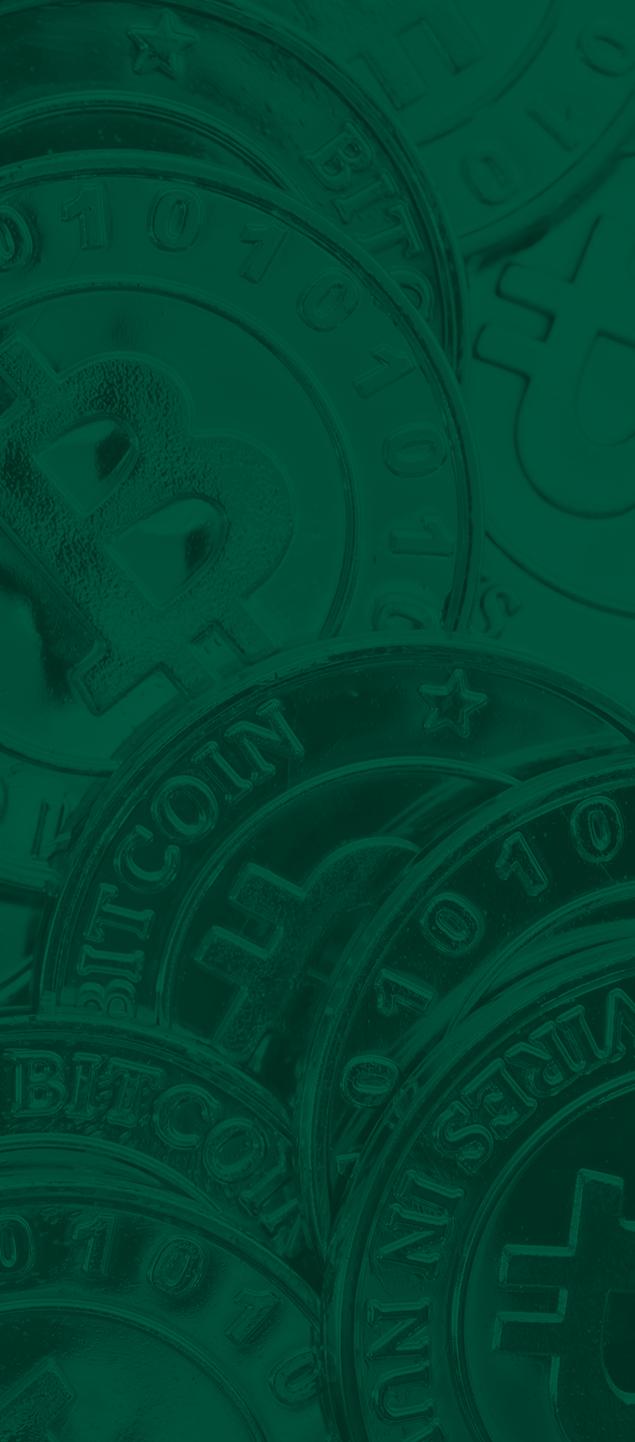
CENTRALIZED EXCHANGE PLATFORMS DECENTRALIZED EXCHANGES (DEX) CRYPTOCURRENCY LENDING PLATFORMS CRYPTO WALLETS RECOMMENDATION ANALYSIS OF CRYPTO EXCHANGES 41
CENTRALIZED
Centralized cryptocurrency exchanges are third-party intermediaries who help everyday crypto traders execute trades by connecting market participants, eliminating the need for on-chain trading skills and simplifying the overall crypto trading process. They operate in a similar way to traditional equity brokerages, such that they collect fees for their services to turn over a profit and maintain operations. Centralized exchanges are also subject to US government restrictions because they are licensed companies that must comply with industry regulations.
Centralized exchanges are helpful for retail investors because they make cryptocurrency trading easy and convenient. However, they are not necessarily feasible for institutional investors due to their relatively high fees and spreads. Most centralized exchanges are custodial, meaning they hold access to the user’s individual private keys. This poses a security risk to the use of centralized exchanges because, despite strict regulations, investors on these platforms do not technically own their crypto; they only own the rights to their crypto.
COINBASE is a cryptocurrency exchange platform based in America. The company operating the platform was founded in 2012 and IPO’ed in April 2021. It currently operates in 100+ countries and has 89 million users. The platform boasts $278 billion of assets and has the most extensive product offering in the United States, with plans to launch an NFT marketplace. Coinbase does not offer futures contracts due to U.S. regulations, and fees on the platform are more expensive than on comparable exchanges, primarily targeting the exchange toward retail investors.

CRYPTO.COM is a cryptocurrency platform founded in 2016. The platform is based in Singapore and serves more than 10 million users across 90 countries worldwide. The exchange platform has recently gained traction due to heavy marketing campaigns in major sporting and entertainment events. It boasts high security, low fees, and impressive liquidity and promises to expand its product offerings by developing an NFT platform. However, Crypto.com does not offer a derivative platform due to regulatory issues, and like other platforms, its US coin offerings are limited. Crypto.com also has potential ESG risks within its management team, as Kris Marszalek, the current CEO, was accused of fraud at his previous company.
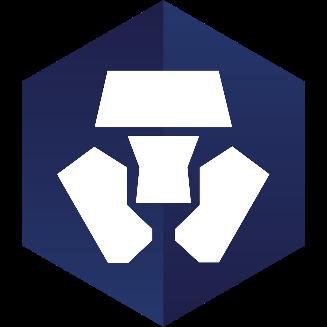
EXCHANGE PLATFORMS (LOW = 1 - HIGH = 5) PRODUCT OFFERINGS REGULATION, JURISDICTION & SECURITY INSTITUTIONAL BENEFITS VOLUME POPULARITY FEE STRUCTURE Coinbase 2 4 2 5 5 1 Crypto.com 3 4 2 5 5 3 Gemini 4 5 4 4 2.5 3 BinanceUS 4 2 3 5 4 2.5 FTX US 1 3 2 3 3 3 Kraken 4 4 3 4 3 2 42
GEMINI was founded in 2013 and is based and regulated under US regulatory requirements. Its coin offerings are slightly below average and derivative markets are not offered, but the fee structure is comparatively good. Gemini also presents a lending platform that offers up to 8% APY and is regulated and suitable for retail and institutional investors. Since its inception, Gemini has not encountered any noteworthy security problems and has strongly regulated policies, making it one of the safest accessible US platforms.

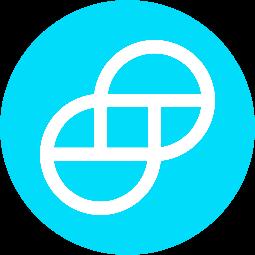
FTX is one of the newer and fastest-growing exchange platforms. It has regulated entities in the United States and Japan and is operational in more than 100 countries through its FTX International Platform. It penetrated the cryptocurrency market in 2020 by pioneering derivative trading on cryptocurrency throughout Europe and Asia, where it also offers a wide range of coins. However, its futures trading has limited capabilities within the United States. FTX U.S. operates under a separate jurisdiction to its governing body, FTX International, with significantly fewer coin offerings than other US platforms.
BINANCE was founded in 2017 and has dominated the cryptocurrency market as it currently holds the largest global market share. It has a broad coin offering, including derivatives, a competitive fee structure and offers separate platforms explicitly designated for institutional investing. However, Binance was previously banned from the United States in 2019 before opening Binance.US, which operates strictly under US government regulations. Binance.US also has sufficient coin offerings and an affordable fee structure but has regulatory risks, with Bloomberg News reporting on government investigations into money laundering and tax evasion in May 2021.

KRAKEN is a centralized cryptocurrency exchange founded in 2011. It is based in the United States and provides multiple trading tools, including derivatives, leverage trading, and staking options, each in various crypto and fiat currencies options. The platform offers its service in 176 countries worldwide with 4 million active users. Kraken has a reputation for security and reliability and maintains fees of up to 1.5% per trade or 0.9% for stablecoin purchases. However, the platform’s advanced features and technical interface can make it a complicated platform for beginners to use.

43
DECENTRALIZED EXCHANGES (DEXs)
Decentralized crypto exchanges are decentralized applications (dApps) built on blockchains that offer and coordinate the trading of crypto assets between users. DEXs differ from a centralized exchange because they do not involve any third-party financial intermediary between market participants. Instead, they operate through open-source, large-scale automated algorithms based on smart contract technology to match buyers and sellers.
The appeal of decentralized exchanges is they generally do not need to operate according to government regulations because they are not controlled by a profit-generating company. This also means they have a lack of fees and minimal spreads because they do not need large profits to run a centralized business. The other fundamental benefit of DEXs is that they are non-custodial and are accessed through crypto wallets such as MetaMask and Ledger Nano X, allowing the user complete control over their private key.
UNISWAP is a decentralized platform that serves as an automated market maker for token swaps. Due to its nature as an AMM, fees on Uniswap are lower than at the major nonDeFi exchanges because they are only used to reward liquidity providers instead of generating profits for the exchange. Uniswap is non-custodial, which means unlike exchanges such as Coinbase or Gemini, users hold full access to their individual private keys. Uniswap runs on the Ethereum platform and offers swaps for ERC-20 tokens, which means tokens like BTC or LUNA can only be swapped in their “wrapped versions.”
Built on the Ethereum blockchain, Uniswap is considered an extremely safe platform for conducting crypto-transactions.

DYDX is the most popular derivative-based DEX by trading volume as of April 1, 2022. As the name suggests, the Layer-2 platform built on the Ethereum network provides various derivative products. The main difference between its centralized derivative platform counterparts is the protocol is publicly available. This makes the settlements of derivatives fully transparent to the user. DyDx also offers spot markets and lending functionality, and for all platforms it is noncustodial, allowing users to hold their own private keys. Fees are generally cheap compared to centralized exchanges and are used to ensure the liquidity and functionality of the platform.
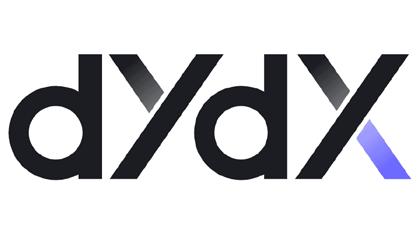
44
CRYPTOCURRENCY LENDING PLATFORMS
CENTRALIZED LENDING PLATFORMS
Centralized lending platforms operate liquidity pools wherein cryptocurrency investors can deposit funds for passive returns or borrow funds at relatively small interest rates. This type of investment is comparable to fixed-income investment in corporate or government bonds. Centralized lending platforms follow a simple three-step process to pay their investors:
1. The investor loans their crypto to the lending platform, which then takes ownership of that cryptocurrency.
2. The company loans that crypto to institutions.
3. The returns from those loans are paid as interest to the initial investor.
Following this methodology, centralized crypto lending platforms are a legitimate source of income, with inherent risk typical of cryptocurrency investment. However, in terms of risk analysis, it is important to note that centralized lending platforms control the user’s private keys to their crypto wallets. This is a major concern with centralized platforms and an important reason investors should shift towards DeFi lending platforms.
CELSIUS was founded in 2017 by inventor Alex Mashinksy and entrepreneur Daniel Leon. It currently has more than 1.7 million users, with a total asset pool of approximately $19.7 billion USD. The platform offers interest on three asset types: stablecoins, cryptocurrencies and gold tokens. Celsius uses its “Earn in CEL” feature to pay investors in Celsius tokens and boost APY returns on stablecoins with further potential for compounding returns as CEL token value increases. At the time of writing, the highest APY return offered by Celsius is 14.05% on SNX token. Celsius also provides loan products where users can use their cryptocurrency as collateral for loans paid out in stablecoins or USD.
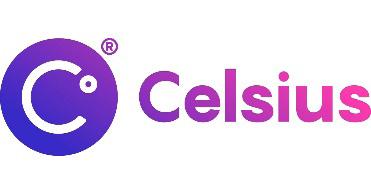
NEXO operates in more than 200 jurisdictions and has captured the European market, differentiating itself from platforms such as Celsius and BlockFi, which are predominantly based in the United States. As explained by founder Antoni Trenchev, Nexo was founded to give users access to the liquidity in their cryptocurrency assets without the need to sell those assets. Nexo offers the same lending and borrowing services as Celsius and BlockFi, as well as a credit card that can be used worldwide, which is particularly attractive to non-US users. Nexo also offers slightly higher returns on its interest products, with 10% APY on USDT compared to 7.1% for Celsius.
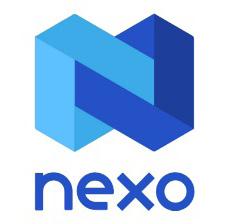
CELSIUS FACT FILE (AS OF APRIL 20, 2022) USERS 1.7 million TOTAL ASSETS $19.7 billion NUMBER OF STABLECOINS 12 NUMBER OF CRYPTOCURRENCIES 36 NUMBER OF GOLD TOKENS 1 NEXO FACT FILE (AS OF APRIL 20, 2022) USERS 4+ million TOTAL ASSETS $12+ billion NUMBER OF STABLECOINS 6 NUMBER OF CRYPTOCURRENCIES 33 NUMBER OF GOLD TOKENS 1 45
DECENTRALIZED LENDING PLATFORMS
Decentralized lending platforms operate very similarly to centralized lending platforms, such that they offer passive income rewards for investing in liquidity pools. However, there are some important differences to note between DEX lending and centralized lending. The major benefit of centralized crypto exchanges is the ease of fiat conversion. Centralized exchanges are run by legitimate companies that must have reserves in fiat and crypto assets. Their status as legitimate companies also implies they are liable in case of security breaches, which would increase the likelihood of recovering assets in such an event. However, centralized exchanges have custody over their user's private keys. This is the major attraction of DEX lending because it allows users full authority over their private keys, making the risk of running into an exit scam much less severe on DEX lending platforms.
CURVE is a popular DEX compatible with many major blockchains and provides swap services at low fees and minimal slippage. Curve is supported by Ethereum, Avalanche, Polygon, Harmony and other DeFi networks. Liquidity pools on Curve generally consist of highly correlated assets, which incentivizes staking because impermanent losses are generally less severe in those pools. This is Curve’s major differentiating factor, as the Automated Market Maker can operate efficiently despite its low fees. The network rewards liquidity providers through interest and the distribution of its native governance token CRV. Despite its exceptional interoperability, Curve struggles to find enough borrowers to match the total value locked in the network, which causes rewards and yields to be relatively low.

AAVE is an open-source liquidity protocol that offers lending and borrowing services for various crypto assets. Most of the protocol’s interest-bearing crypto assets are locked into the Ethereum or Avalanche ecosystem, but Aave also makes markets on Harmony, Fantom, Polygon and other networks. The rates offered by Aave are not as high as on comparable DEXes. To ensure liquidity, the protocol automatically adjusts borrowing and lending rates, implying that natural economic forces keep Aave markets at equilibrium unless major shocks were to occur. With roughly $18 billion in TVL, including staking across seven different networks, Aave is amongst the four largest DEXes in the DeFi space and provides services to an established customer base ranging from retail to institutional investors.
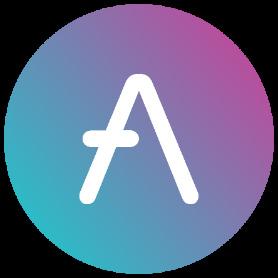
46
CRYPTO WALLETS
Crypto wallets let users store their private keys and access the crypto assets when needed by connecting the wallet to an exchange or dApp. Wallets come in different forms referred to as cold wallets and hot wallets wherein the keys can be stored offline or online.
Cold wallets are physical assets considered to be the safer storage method and are more relevant when large sums of crypto assets need to be stored. Cold wallets mitigate the risk of cybercrime but do have traditional storage risks where theft or the unexpected passing of the user could potentially lead to the loss of crypto assets. Safety of storage also comes with a trade-off because it is more laborious to access the crypto assets in a cold wallet, and depending on the location of the physical storage, accessing a cold wallet can be a time-consuming process. Hot wallets are open-source software that allows users to be more flexible, which is beneficial when using active trading strategies. Major hot wallet providers also typically provide an open-source code regarding functionalities, making it easier for users and Web3 auditors to verify the wallet’s legitimacy.
METAMASK is a popular hot wallet for retail cryptocurrency investors. It is a non-custodial, open-source wallet, making it more secure than wallets connected to centralized exchanges. A MetaMask wallet is accessible through browser extensions that are easily downloaded from the internet and connect the wallet directly to the Ethereum blockchain. MetaMask charges small fees for conducting on-chain transactions and cryptocurrency swaps for its users. MetaMask’s swap services interact directly with the DEX without requiring the user to be proficient with the DEX’s interface.

LEDGER NANO X is among the most popular cold hardware wallets as of April 2022. The device is compatible with more than 1,800 cryptocurrencies and supports pairing with software wallets such as MetaMask. Like most hot wallets, Ledger Nano X requires a password/recovery phrase that should be stored physically and offline, as it will be the only access to the hardware’s digital assets if the hardware gets lost, stolen or damaged. When the device is connected to the compatible software and overall setup is completed, the user can access the private key of their wallet to receive payments and buy crypto assets across all major blockchains.

RECOMMENDATION
We recommend a diverse set of exchanges and wallets for any crypto investor trading crypto for its long-term vision rather than the excitement of short-term gains. This recommendation stems from exposure to different risks at centralized exchanges, DEXes, hot wallets and cold wallets. The ease of use of a centralized exchange is coupled with higher fees and greater regulatory constraints, whereas DEXes have much lower fees but require greater expertise and have a lower probability of recovery of assets in case of a sophisticated cyber-attack. Additionally, wallets provided by centralized exchanges are often compatible with DeFi wallets, making it easier to transfer funds back and forth. A crypto investor’s choice of storage is recommended to be tailored to individual trading strategies. A long-only portfolio based on fundamental analysis requires infrequent rebalancing, making a cold wallet more attractive, while active trading strategies generally should be conducted through easily accessible hot wallets.
47


MARKET MOVERS ALTERNATIVE INFRASTRUCTURE NFTs AND METAVERSE ADOPTION STABLECOINS FOR DEFENSIVE PORTFOLIO DAPPS & GOVERNANCE FUNDAMENTAL COIN ANALYSIS 49
MARKET MOVERS
ETHEREUM (ETH)
DESCRIPTION
Ethereum is an open-source and data-friendly blockchain platform. Founded by Vitalik Buterin in 2013, the Ethereum network is the No. 1 platform for smart contracts. Ethereum was fully launched in 2014 as an open-source blockchain that aimed to bring smart contract computation to the blockchain. Ethereum will update its blockchain to Ethereum 2.0, which is expected to occur in late 2022. With this new version, Ethereum will become even more powerful in the crypto space and aims to become the No. 1 crypto asset by market cap.

HOW DOES IT WORK
Ethereum currently uses a PoW consensus mechanism with scalability issues, which has led the Ethereum team to transition to a PoS platform by adding a “consensus layer” to the network. The ETH token is primarily a store of value, drives the functions offered within the Ethereum network, and allows users to create and deploy smart contracts. In Ethereum 2.0, the original “execution layer” that represents the original code of the Ethereum blockchain will continue to store the smart contracts and network governance, but each block will be confirmed in the “consensus layer” through its PoS validation method. With this transition, the Ethereum networ will move away from low-transaction volumes and high-transaction fees, allowing for greater network scalability. The Ethereum upgrade will have different phases with different durations. The Beacon chain will first facilitate the PoS system in parallel with the existing system. The introduction of sharding will allow faster transactions with lower fees, and the eventual merger between proof-of-work and proof-of-stake protocols will execute.
COMPETITIVE ADVANTAGE
Ethereum is the largest open-source platform with thousands of dApps running on its blockchain, facilitating anything from wallets to NFTs, DEXes, DAOs, stablecoins and bridges. Ethereum is the leading player in the cryptocurrency industry, and every emerging blockchain is trying to compete with ETH. For example, Ethereum’s DeFi applications dominate the industry, with the leading DEX derivatives and lending platforms built on the Ethereum network. The extensive use of the Ethereum ecosystem provides a robust demand for the network’s native token, ETH. Ethereum 2.0 will enhance these applications and enable a layer-2 solution that offers faster transaction speeds and lower fees. The Ethereum team will make the transition by using sharding techniques that improve the scalability and capacity of Ethereum to up to 100,000 transactions per second while enhancing the security of the network through a higher number of required validators than on competitive blockchains. Hence, Ethereum 2.0 will be more scalable, secure and sustainable.
VISION
Despite its cons, Ethereum remains the No. 1 smart contract platform. With the Ethereum 2.0 upgrade, it will become faster with transaction speeds of up to 100,000 per second and low fees that make it even more attractive. Ethereum 2.0 is expected to be amongst the best blockchains and surpass Bitcoin’s market cap in the long run.
KEY POINTS
Smart Contracts, Ethereum 2.0, Sharding
50
RIPPLE (XRP)
DESCRIPTION
Ripple represents the company behind a technology that acts as both a cryptocurrency and a digital payment network for financial transactions. Ripple’s native token XRP was launched in 2012, making it one of the most longevous and notable cryptocurrencies in the market.
HOW DOES IT WORK
The Ripple network operates on a consensus protocol to validate account balances and transactions on the system, while independent participants maintain the XRP ledger. For each transaction to be successful, there must be an agreement between independent validators. While PoW blockchains produce blocks, compartmentalized segments of the overall chain include specific information for XRPL to create the “ledgers.” Each ledger contains information linking it to the first ledger on the blockchain and account totals. The XRP ledger takes approximately three seconds to confirm ledgers and perform transactions.

COMPETITIVE ADVANTAGE
Ripple aims to provide an efficient system for the direct transfer of money in real-time while being cheaper, safer and more transparent than other transfer systems employed by traditional financial institutions. XRP is the native token used by the Ripple network. Its purpose is to serve as an intermediate exchange mechanism between two networks. Ripple operates on a decentralized, open-source, peer-to-peer platform that allows the seamless transfer of money in a range
of fiat or cryptocurrencies. XRP also acts as a bridge currency to other currencies. Unlike banks, where a transaction can take days or weeks, the Ripple network can settle transactions within seconds with network capabilities extending up to 1,500 transactions per second. The fees for making a transaction on Ripple are also low relative to traditional banking systems. Ripple also operates RippleNet, which aims to reduce costs and increase the speed and efficiency of international payments to help customers improve overseas monetary transfers. RippleNet also involves many participants and focuses on the transparency of transactions.
VISION
Ripple aspires to establish itself as an alternative to SWIFT, the current market leader in international banking. Almost all banks use the SWIFT (Society for Worldwide Interbank Financial Telecommunications) system to process international transactions. Although this system is efficient, it is expensive, and Ripple has the technology to outperform and replace existing banking systems using XRP. Evidence of Ripple’s rise in scalability and expanding network is in Thailand, an international emerging economic market.
KEY POINTS
Digital payment, Low fees, RippleNet
51
ALTERNATIVE INFRASTRUCTURE
AVALANCHE (AVAX)
DESCRIPTION
Avalanche is a smart contract platform used for creating custom blockchain networks and decentralized applications. Launched in 2020 by Ava Labs, its blockchain provides an ecosystem for private and public blockchains. The AVAX blockchain can support multiple custom virtual machines, which are then deployed on a custom blockchain network called a subnet. Avalanche is an emerging smart contract platform and will likely benefit as blockchain technology continues to grow.

HOW DOES IT WORK
Avalanche uses the proof-of-stake consensus mechanism to achieve high transaction speeds. The Avalanche project aims to dethrone Ethereum as the leading blockchain platform for smart contracts by distinguishing itself with its three-pronged approach: customization, scalability and interoperability. The AVAX coin, which has a capped supply, is used to process transactions on the Avalanche network and encourage people to maintain the network through its proof-of-stake consensus algorithm. Validators who stake AVAX coins to maintain the network must stake at least 2,000 AVAX coins, and those who wish to delegate their coins to validators must delegate at least 25 AVAX coins.
COMPETITIVE ADVANTAGE
One of the main competitive advantages of the Avalanche network is the speed at which transactions take place. Avalanche takes less than one second to verify a transaction, and the network can handle more than 4,500 transactions per second. Avalanche also allows anyone to create dApps on their
blockchains, which is beneficial for developers who seek to use open blockchains to build applications and platforms. The Avalanche network is also building a bridge to the Ethereum network so anyone can transfer assets seamlessly between the two networks.
VISION
The developer’s vision for the Avalanche ecosystem is to establish a faster and environmentally sustainable platform compatible with various dApps. Avalanche wants to scale operations within the blockchain industry and create a governance structure in which participants can involve themselves in decision-making processes about the future of the network more efficiently than traditional blockchain networks.
KEY POINTS
Smart Contracts, dApps, proof-of-stake consensus algorithm
52
POLKADOT (DOT)
DESCRIPTION
Polkadot is a decentralized blockchain network that bridges and allows interconnectivity between blockchains. Polkadot was founded in 2016 by a co-founder of Ethereum, Gavin Wood, and coordinated by the Web3 foundation based in Switzerland. Polkadot is currently the largest blockchain project with a primary focus on blockchain interoperability.
HOW DOES IT WORK
Polkadot is a blockchain that describes itself as a “layer-0 protocol” that allows blockchain interconnectivity so data can be transferred across different blockchains. Polkadot’s network runs on a PoS protocol where stakers place their tokens on the blockchain to generate staking rewards and help manage the Polkadot system. The Polkadot network can handle approximately 1,000 transactions per second and uses its native token DOT to send, receive, and govern the network. The other major aspect of Polkadot is its parachains which connect the entire ecosystem. Polkadot blockchain solutions are often described as an airport with various connecting flights from different destinations, sharing and interoperating data and information.

COMPETITIVE ADVANTAGE
Polkadot offers the ability to interoperate between a wide variety of blockchains on the Polkadot network. Polkadot provides economic capabilities that allow a common set of validators to secure and validate blocks simultaneously across multiple blockchains. Additionally, Polkadot also offers transactional
scalability by distributing transaction information across multiple parallel blockchains. The network’s governance structure allows nodes to be independent in their governance decisions while providing collective security features. Network upgrades are coordinated across the chain and implemented autonomously and without forking the network, ensuring Polkadot’s development stays community-driven.
VISION
Polkadot’s vision is to redistribute digital sovereignty from intermediaries to individuals and businesses, as they emphasize commitment to privacy protections, digital transparency and a community-driven financial system open to everyone. Combining individual blockchain products into one ecosystem will be necessary to allow blockchain technology to be fully adopted in our centralized world.
KEY POINTS
Smart Contracts, Parachain
53
ALTERNATIVE INFRASTRUCTURE
SOLANA (SOL)
DESCRIPTION
Solana is a decentralized blockchain platform for builders that create dApps globally. Solana is one of the fastest blockchains in the crypto industry and is enjoying rising popularity among recent blockchain projects, especially with regards to the NFT space.
HOW DOES IT WORK
Solana runs on a hybrid protocol using the Proof of History (PoH) and Proof of Stake (PoS) consensus mechanism. The decentralized blockchain has smart contract capabilities that allow dApps and NFT projects to be deployed. The Solana token SOL is used for network security through staking and payment for fees associated with running smart contracts or transactions.
COMPETITIVE ADVANTAGE
Its Proof of History model allows Solana’s network to have 65,000 transactions per second. Transactions on Solana cost an average of $0.00025, which is why it is attracting users. Another important aspect that makes Solana’s blockchain special is that it is scalable at its base level, which means it does not require layer-2 solutions to increase scale. While the DeFi and non-fungible token (NFT) ecosystems have taken off during 2021, the Solana blockchain offers what Ethereum’s base layer currently cannot: fast transactions at a low cost. As a result, activity on the Solana blockchain has grown rapidly, both in terms of creating decentralized applications (dApps) and transactions. With billions of dollars being locked up in
Solana’s dApps, the network holds enough capital to further develop DeFi applications. In response to the NFT boom and the development of competitive dApps, Solana’s token SOL grew substantially in 2021 with a price increase of more than 11,000%.
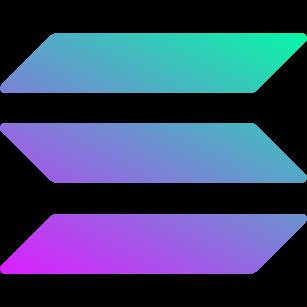
VISION
Solana is still in its early stages and has enormous potential as faster transactions with lower costs are provided. The adoption of its dApps, coupled with superior transaction infrastructure, will drive the network’s long-term growth.
KEY POINTS
Proof-of-History, Smart contract
54
CARDANO (ADA)
DESCRIPTION
Cardano is a third-generation decentralized blockchain for developers, describing itself as a network for dApps that generate positive global change. The platform was launched in 2017 by Charles Hoskinson, a co-founder of the Ethereum network, and it is one of the most advanced global blockchain platforms.

HOW DOES IT WORK
Cardano’s primary goal is to create a digital currency economy with its ADA token. Cardano uses a PoS consensus protocol for its blockchain. The Cardano blockchain’s financial system operates in two layers; the primary layer consists of Cardano Settlement Layers, built to enable a digital currency economy with ADA as the native currency, while the second layer is the Cardano Computation layer for smart contracts. Like other alternative infrastructure, Cardano offers more than just a digital currency, but also an ecosystem for innovative dApp development.
COMPETITIVE ADVANTAGE
Cardano uses a PoS protocol called Ouroboros. Ouroboros combines unique technology and mathematically verified mechanisms to ensure the security and sustainability of the blockchain, with an incentive mechanism that rewards network participants for their participation. Ouroboros distributes control of the network through stake pools. The pools use special systems to designate a slot leader for each stake pool and then reward participants in the pool for adding a block
to the chain. Instead of waiting to be delegated, ADA holders can also charge their stakes to specific pools to increase their chances of being selected as the slot leader and partially sharing in the pool’s rewards. The Cardano network is highly scalable and can process 45,000 transactions per second. Cardano has partnered with universities, governments, and companies and is well-positioned to take advantage of industry tailwinds as the blockchain and cryptocurrency sector grows. According to the Cardano team, Bitcoin’s scripting language is too rigid, and Ethereum’s Solidity language is too complex. Cardano claims its scripting language, Simon, is simpler for dApp development than competitors, allowing for widespread peer review and more robust security and script execution.
VISION
Cardano’s vision is to revolutionize finance for emerging markets around the world. It also aims to restore trust to the global financial market with more secure, sustainable and transparent activities through Ouroboros.
KEY POINTS
Ouroboros, Speed, Easy Coding Language
55
ALTERNATIVE INFRASTRUCTURE
NEAR PROTOCOL (NEAR)

DESCRIPTION
NEAR Protocol is a user-friendly decentralized application organization (DAO) founded by Alex Skidanov and Illia Polusukhin, former Microsoft software developers. NEAR Protocol is a layer-1 blockchain competitor to Ethereum and was created in 2018.
HOW DOES IT WORK
NEAR Protocol is a proof-of-stake (PoS) blockchain that aims to compete with other blockchains by using sharding as a solution to scale its blockchain. Essentially, it uses a technique called its Nightshade Design to allow dynamic sharding without a limit on the number of shards while also creating and merging shards as the network needs. This technique enables an estimated 100,000 transactions per second for a meager cost. NEAR Protocol has also created an application called Rainbow Bridge that allows participants to quickly transfer Ethereum tokens across Ethereum and NEAR. A layer-2 scaling solution called Aurora was built on top of the NEAR Protocol for developers eager to launch their decentralized Ethereum applications on the NEAR network. Aurora uses Ethereum’s coding technology, which allows it to use the Rainbow Bridge. Developers can use Aurora to take advantage of the benefits of the NEAR Protocol with the low transaction costs while accessing Ethereum applications.
COMPETITIVE ADVANTAGE
The token, NEAR, can be used for transaction fees and storing data. It is also used in the staking process to operate validation nodes within the network. Participants in the network can use
the token to influence the network’s decision by participating in the governance procedures. Applications on NEAR must pay a storage fee to the NEAR Protocol for any data they store on the blockchain. The network “burns” these tokens, which reduces the supply of circulating NEAR tokens. Validators receive a reward for maintaining the security and validity of the NEAR blockchain by locking their tokens into the network. The NEAR Protocol is inflationary, as its token supply increases by 5% each year, with 90% of these newly released tokens going to validators with the remainder going to the blockchain’s treasury to support the platform’s development.
VISION
NEAR Protocol is a very secure and user-friendly application that implements sharding and has enormous potential for scaling. With Rainbow Bridge and Aurora, developers building on Ethereum can benefit from the NEAR Protocol and support the Ethereum network long-term.
KEY POINTS
Smart contract, Sharding, Rainbow Bridge, Aurora
56
COSMOS (ATOM)

DESCRIPTION
Cosmos is a blockchain that powers an ecosystem of subsequent blockchains designed to scale and interoperate with each other. The Cosmos network was created in 2014 by Cornell computer scientist Jake Kwon. After receiving significant funding, he coauthored the Cosmos white paper and released the software in 2019. The project aims to create an “internet of blockchains”; a decentralized network of blockchains able to facilitate open communication between blockchains.
HOW DOES IT WORK
Cosmos is a PoS blockchain where ATOM holders can stake their tokens to maintain the network and receive ATOM tokens as a reward. The main idea of Cosmos is to allow for faster and cheaper decentralized applications focused on NFT marketplaces and decentralized exchanges. Cosmos sets itself apart from some similar blockchains through its “dedicated” blockchains, which provide developers with prebuilt and entirely customizable blockchain modules for specific and fast development. All of the dedicated independent blockchains are interconnected by the Cosmos Inter-Blockchain Communication (IBC) protocol.
COMPETITIVE ADVANTAGE
Cosmos addresses the issue of interoperability of cryptocurrencies by allowing interaction between blockchains through its IBC consensus engine. Similarly to other alternative infrastructures, Cosmos focuses on security, transaction cost and speed that developers receive from other major blockchain platforms. The platform recently integrated with the Ethereum
network and launched its own DeFi interface. Today, nearly 20 companies are actively working on the Cosmos network to build scalable and interoperable blockchains with the special “dedicated” prebuilt blockchain modules.
VISION
Cosmos seeks to interconnect blockchains using its IBC network. Its ability to connect and link to the Ethereum network places it advantageously among the emerging cryptocurrency market by focusing on flaws of crypto, such as interoperability and scalability. However, the most significant differentiator for Cosmos is its method of separating applications on different blockchains while retaining interconnection for faster and cheaper operational use cases.
KEY POINTS
Inter-Blockchain Communication
57
ALTERNATIVE INFRASTRUCTURE
HARMONY (ONE)
DESCRIPTION
Harmony is an open-source blockchain for decentralized applications. It was designed as an interoperable level-two scaling solution for Ethereum. Harmony creator Dr. Stephen Tse, lead developer of Google Maps, and his team have built innovative Layer-2 scaling solutions for Ethereum, working on its blockchain. Harmony was launched in 2019 to become a leading competitor of Ethereum.
HOW DOES IT WORK
Harmony was designed to solve problems that arise on the Ethereum network. Harmony is a layer-1 blockchain that uses effective PoS and sharding techniques to achieve a blockchain’s primary goals: scalability, security and decentralization.
COMPETITIVE ADVANTAGE
Harmony scales its network by sharding, dividing validators into multiple groups, and allowing them to approve transactions and new blocks simultaneously. Harmony can process 2,000 transactions per second while maintaining minimal fees. Harmony’s blockchain is more energy-efficient than many more established blockchains. It uses a PoS consensus mechanism, as participants put existing tokens as collateral to have a chance of being randomly selected to validate transactions. For a block to be approved, multiple validators must verify transactions. Another noteworthy feature of the Harmony blockchain is connecting blockchains through its bridge called Horizon. Horizon is a cross-chain connectivity gateway with Ethereum, allowing the exchange of assets between the two networks. This innovation could
potentially revolutionize cross-border payments and make cryptocurrency trading more convenient. By allowing nodes on other blockchain networks to validate transactions, Harmony’s platform can transfer data across various blockchain networks, whether they utilize PoS, PoW or other consensus algorithms. Additionally, Harmony is an excellent platform for developers of NFT projects. The network’s cross-chain capabilities open up exciting possibilities for NFT transfers, and the low transaction fees could make the network attractive to NFT developers.

VISION
Harmony has also established connections to other blockchains, such as Binance’s Smart Chain, but is also working on establishing bridges to multiple other networks. Due to its excellent Web3 infrastructure, Harmony will scale if the crypto ecosystem as a whole can be adopted at a rising pace.
KEY POINTS
Smart contract, Sharding, Horizon Bridge
58
TERRA (LUNA)
DESCRIPTION
LUNA is a decentralized blockchain that provides a network for creating dApps on the Terra ecosystem. The company behind the TERRA ecosystem is Terraform Labs, based in South Korea. The network rapidly rose in popularity in 2021 due to its algorithmic stablecoin TerraUSD, which has shown immense growth in usage and market capitalization throughout 2021. Being one of Ethereum’s biggest competitors, the Terra blockchain was particularly popular in the DeFi space. In May 2022, during an industry-wide crypto sell-off, the native stablecoin UST lost its peg to the US Dollar, causing the project to fail.
HOW DOES IT WORK
The Terra blockchain uses PoS consensus, and the platform offers stablecoins in fiat currency to ensure stability in crossborder payments. Terra is powered by its own Luna token, used for utility and governance to run the collateral mechanisms that were supposed to support and guarantee the Terra network’s stablecoin price. The prospect of becoming a liquidity provider has prompted many investors to hold TERRA stablecoins and the LUNA staking asset to receive rewards from the network. The network has added a growing number of dApps, which has caused the value of the LUNA token to jump in early 2022, primarily as LUNA’s native lending and earning platform, Anchor protocol, has become increasingly popular. With the Anchor protocol offering much greater lending rewards than markets would suggest, it certainly played a major role in the collapse of the Terra network.

PROPOSED COMPETITIVE ADVANTAGE & LUNA'S COLLAPSE
The Terra platform allows developers to create digital applications on the Terra network. Two of the DeFi protocols based on Terra are the Anchor protocol, which provides incentive-based staking services, and the Mirror protocol, which allows for the creation and use of synthetic assets. In addition to the services built in the Terra ecosystem, the protocol aims to become fully interoperable with other layer-1 blockchain solutions. Tokens can be moved to and from multiple blockchains simultaneously. Terra Bridge is a protocol that allows users to send and exchange Terra to other blockchains like Ethereum or Binance’s Smart Chain assets. Despite higher scalability than competitors and sophisticated dApps, the core of TERRA is the creation of an ecosystem surrounding algorithmic stablecoins. Once the core component of the project failed, the Terra ecosystem self-destructed. The hyperinflationary minting of LUNA tokens caused by the sale of de-pegged UST tokens created a vicious circle, in which LUNA and UST tokens were sold at a rapid pace, causing each token to lose its utility.
FINAL WORDS
Blockchain projects are risky investments, and even sophisticated research does not always protect against faulty projects. At its peak, LUNA was one of the most valuable tokens in the crypto-space, implying that retail and institutional investors did not spot the project’s incompleteness as they enjoyed short-term gains. The moral of LUNA’s collapse: “If it’s too good to be true, it probably is.”
KEY POINTS
Smart contract, Stablecoin, DeFi
59
NFT & METAVERSE ADOPTION
DECENTRALAND (MANA)
DESCRIPTION
Decentraland is an open-source interactive virtual reality platform where users can buy and build virtual land through the Ethereum blockchain. This game has no fundamental objective; however, users traverse a virtual world and purchase virtual land that is tokenized through “LAND” tokens. Decentraland was created by Esteban Ordano and Ari Meilich in 2017 and offers the possibility for millions of players to discover a revolutionary virtual reality: The Metaverse.

HOW DOES IT WORK
Decentraland is an interactive 3D world divided into 90,601 individual LANDs, each represented by a non-fungible ERC721 token representing digital ownership of the given “Land.” Each LAND has a particular coordinate in the Metaverse and is used to define ownership of a piece of land, revolutionizing digital real estate. The number of grounds a user can build is limited, having an area of 16 x 16 virtual meters with a zero-height limit. The platform guarantees its users property rights and a permanent record of ownership on the Ethereum blockchain. Decentraland’s native token MANA is an ERC20 token that allows users to purchase LANDs and virtual goods used in Decentraland.
COMPETITIVE ADVANTAGE
Decentraland offers a marketplace where digital land has to be purchased through MANA tokens. Users can use the MANA token to trade and manage their land token and purchase ingame items, such as avatars or clothing. Game members also participate in the Decentralized Autonomous Organization
(DAO) of the platform. As a DAO, Decentraland allows its community to participate in the project’s governance by voting on the code of conduct of the Decentraland world, proposing and voting on policy updates, the specifics of future LAND auctions, and the types of content allowed in the Metaverse. Decentraland enables its users to build anything on your LANDs, which opens up vast possibilities for the Decentraland project. It has gained a lot of attention due to the recent NFT and Metaverse hype. Many brands such as Coca-Cola, Nike and Samsung have entered the Metaverse by acquiring NFTs (ERC-721 tokens) in the virtual world. Entering Decentraland could become an attractive marketing opportunity for brands attempting to gain traction in the Metaverse, as firms can gain visibility and exposure by building items with brand names on them.
FINAL WORDS
The Metaverse is a concept still in its infancy. Decentraland is already the niche leader for Metaverse infrastructure. With the game’s technology continuing to advance, the popularity of the Metaverse growing and the number of players increasing, Decentraland is set to become a widely-adopted platform in the cryptocurrency industry.
KEY POINTS
Metaverse, NFTs
60
STABLECOINS FOR DEFENSIVE PORTFOLIO
DAI (DAI)
DESCRIPTION
DAI is a decentralized stablecoin launched in 2017 by the Maker decentralized autonomous organization. It is an opensource platform key to the MakerDAO lending system. DAI is one of the largest DeFi stablecoins on the market and was created to revolutionize stablecoins by facilitating crypto lending without relying on fiat-backed stablecoins.
HOW DOES IT WORK
Decentraland is an interactive 3D world divided into 90,601 individual LANDs, each represented by a non-fungible ERC721 token representing digital ownership of the given “Land”. Each LAND has a particular coordinate in the metaverse and is used to define ownership of a piece of land, revolutionizing digital real estate. The number of grounds a user can build is limited, having an area of 16 x 16 virtual meters with a zero-height limit. The platform guarantees its users property rights and a permanent record of ownership on the Ethereum blockchain. Decentraland’s native token MANA is an ERC20 token that allows users to purchase LANDs and virtual goods used in Decentraland.
COMPETITIVE ADVANTAGE
In addition to being a stablecoin that hedges against general market risks, DAI stands out for its stability compared to similar unsuccessful algorithmically stabilized coins. Many other stablecoins are fiat-collateralized, meaning an actual U.S. dollar backs these other currencies in a bank account and someone is providing real money to support the tokens. In addition, the issuance and regulation of these tokens are then
controlled by the companies that govern them, which removes the “decentralized” nature of cryptocurrencies. The creators of USDT and USDC have price-manipulation capabilities and owner information, which could not happen on a truly decentralized network. Thus, DAI has an obvious competitive advantage. Moreover, Maker cryptocurrency backs DAI, using an over-collateralization system of 1.5:1, meaning the value of the crypto assets used as collateral exceeds the amount of DAI you receive, which caused DAI to remain stable during the collapse of UST, which was partially caused by an industrywide crypto selloff. DAI also adheres to general blockchain transparency and reliability, with all changes to smart contracts visible to all blockchain participants.
VISION
DAI’s long-term future goal is to be the “first unbiased currency.” DAI has the platform and ability to be a global currency due to its algorithmic stabilizing and over-collateralization. However, DAI will have to be adopted and used by millions of people, which will require immense branding, marketing and education by the Maker DAO.
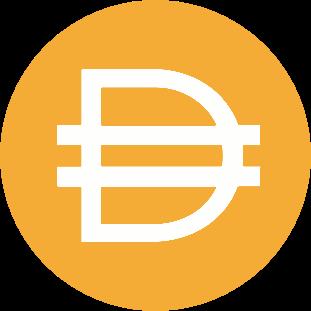
KEY POINTS
Stablecoin, Algorithmic Stablizing
61
DAPPS & GOVERNANCE
POLYGON (MATIC)
DESCRIPTION
Polygon is a decentralized Ethereum scaling platform (layer-2 platform) that allows developers to create scalable, userfriendly dApps with low transaction fees. The Polygon platform was launched in 2017 to connect and grow Ethereum-enabled projects. MATIC is the ticker symbol of its token, which is used to govern and secure the Polygon network and pay transaction fees.
HOW DOES IT WORK
Polygon uses a modified PoS consensus mechanism that verifies every block. The PoS method requires network participants to stake their MATIC in exchange for the right to validate Polygon network transactions. With Polygon being a level-two scaling solution for the Ethereum blockchain, these solutions work on top of an existing blockchain network rather than using the underlying blockchain. The Polygon network aims to address the limitations of the Ethereum platform, namely high transaction fees and slow transaction processing.
COMPETITIVE ADVANTAGE
Polygon presents its services as a framework for an “Internet of blockchains,” meaning it can connect any blockchain interoperable with Ethereum. Polygon can deploy existing blockchain networks and develop custom blockchains. It can also enable communication between Ethereum and other blockchains in helping existing blockchains become more compatible with Ethereum. By using a consensus mechanism that completes the transaction confirmation process in a

single block, Polygon can maintain fast transaction processing speeds. Polygon’s average block processing time is 2.1 seconds, and transaction fees are low at approximately $0.01.
VISION
Polygon plans to expand beyond Ethereum as it has the technology to outpace its competitors with its layer-2 scaling solution for the Ethereum blockchain. The platform has developed several Ethereum scaling solutions with major funds like Polygon Pos, Polygon Hermez, Polygon NightFall, etc. Polygon’s developers want to establish the platform as a leader in Web3 technology. Developers are building many digital applications on the Polygon ecosystem that enable the use of its MATIC token.
KEY POINTS
Layer-2 on Ethereum, Transaction Speed
62
TEZOS (XTZ)
DESCRIPTION
Tezos is an open-source blockchain through which developers worldwide build and engage with a network of decentralized applications. The Tezos blockchain was created in 2014 by Arthur Breitman and his wife through their startup Dynamic Ledger Solutions, which then was involved in the development of Tezos. Tezos has multiple applications on its blockchain, making it one of the projects with a bright future in the crypto industry.
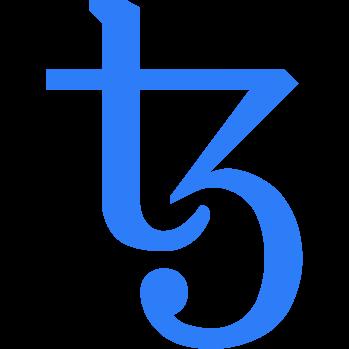
HOW DOES IT WORK
Tezos is a competitor to Ethereum; although both are based on smart contracts, there are significant differences. Tezos is an open-source platform where developers can evolve and improve the blockchain over time without any danger to the work. Tezos uses a variant of the classic PoS consensus called liquid proof-of-stake (LPoS) to keep its network in sync. LPoS is a consensus mechanism similar to traditional PoS. The critical difference is participants can delegate their voting rights to other participants without relinquishing their token ownership.
COMPETITIVE ADVANTAGE
Tezos users use its native token, XTZ, for transaction and smart contract execution fees. XTZ plays a central role in Tezos’ consensus mechanism and blockchain governance system. Users stake XTZ tokens directly on the network to participate in the validation of transactions and blocks. All tokens placed on the platform receive a reward from newly distributed XTZ
tokens proportional to the number of tokens staked. Through its LPoS staking variation, XTZ holders who lack the resources and technical ability to stake directly can delegate their voting rights to other participants. This model differentiates itself from other emerging PoS blockchains because it allows any qualified investor to participate in the governance system of the Tezos chain. To qualify for governance participation, investors must stake a minimum of 8,000 XTZ.
VISION
The Tezos ecosystem is increasing with multiple partnerships around it. Société Générale, one of the largest French banks, has launched its stablecoin called Lugh, which is pegged to the Euro on the Tezos blockchain. The collaboration with the bank is not the only partnership attracting attention to the network. Tezos has also entered into numerous partnerships with sports teams for token issuance like Red Bull and McLaren to launch the team’s first NFTs on its blockchain. Tezos’ dApps are proliferating, and NFTs projects are an essential part of that. Tezos has the technology and ability to compete against competitive blockchains to gain more market share in the crypto industry.
KEY POINTS
Smart contract, LPoS
63

GLOSSARY

65
51% ATTACK
A 51% attack is when a single person or entity gains control of more than 50% of a blockchain’s hashing power. Preventing a 51% attack is the main goal of a blockchains consensus mechanism.
ALGORITHMICALLY-STABILIZED
The process of pegging the value of a stablecoin to a fiat currency by pairing a stablecoin to a crypto asset of noteworthy value and algorithmically controlling the token’s supply. Thus, increasing or decreasing the stablecoin’s value and incentivizing arbitrageurs to maintain the stablecoin’s peg.
ALTCOINS
Abbreviation for Alternative Coin, generally defined as any cryptocurrency other than BTC.
AMM
Automated Market Makers rely on smart contracts in liquidity pools to facilitate trades in the open market rather than financial intermediaries.
BITCOIN DOMINANCE
Defined as the ratio of Bitcoin’s market cap to the rest of the cryptocurrency market.
BLOCK
A block is the data structure within the blockchain where information, data, or records often detailing financial information on the exchange of assets, are collected in a transaction list or general ledger.
BLOCKCHAIN
A secure, digital record of information protected by cryptography.
BRIDGE
A tool used to conduct transactions across two different blockchains. Bridges are necessary to scale Web3 applications across blockchains.
BUBBLE RISK
The risk of investors bidding-up the value of an asset far beyond its intrinsic value. Eventually, this can lead to a collapse in the asset’s price if it incurs a rapid decrease in demand.
CENTRALIZED EXCHANGE
Centralized Exchanges offer cryptocurrency purchases and trades that are managed by a central regulated business rather than on a peer-to-peer basis.
COLD WALLET
Cold wallets allow users to securely store their crypto assets off-line. When the user is off-line, the private keys within the wallet also move off-line, which means they are accessible without an internet connection.
CONSENSUS MECHANISM
A mechanism for verifying the legitimacy of activity on a blockchain.
CPI
The Consumer Price Index measures inflation by comparing prices for the average basket of consumer goods year-overyear.
CPU
The Central Processing Unit that performs the basic arithmetic and trial-and-error logic methodology for PoW mining.
66
CRYPTO-COLLATERALIZED
The process of securing an asset’s or a loan’s legitimacy by pledging respective crypto assets to the counterparty in case of default.
CRYPTOCURRENCY
A digital unit used for financial transactions maintained through cryptography instead of centralized institutions.
CUSTODIAL
Custodial exchanges hold crypto-assets for its users. They can be held liable if assets are lost.
dAPPs
dApps are decentralized applications built on a blockchain network. Applications for dApps range from finance to entertainment.
DAO
Decentralized Autonomous Organizations are communities with a decentralized governance structure that controls the DAO and its activities.
DEFI
Decentralized finance is a term used for financial services and marketplaces that do not require a middleman to conduct transactions and are typically executed through smart contracts.
DERIVATIVES
Financial instruments that derive their value from the price movements of an underlying asset.
DEXES
DEXes are decentralized exchanges. The term represents finance-related dApps. No intermediaries are needed and tokens can be traded at low cost.
DIFFICULTY TARGET
A block’s difficulty target is a dynamic parameter in the blockchain that alters how hard a miner must work to solve the next block. The purpose of a difficulty target is to proportionally adjust the mining power required to solve the next block, so even as technology improves blocks are still mined at an almost constant rate.
DISTRIBUTED LEDGER
A digital system designed for recording transactions across different geographic locations without the need for centralized data storage.
ECOSYSTEM
A group of cross-enterprise workflows interacting to provide an environment for blockchain technology collaboration.
ERC-20
Ethereum uses the ERC-20 standard to approve the functionality of smart contracts used on the Ethereum blockchain. The code of a smart contract has to meet prespecified conditions to achieve the ERC-20 standard.
EROS
A philosophical concept developed by Sigmund Freud referencing an individual’s drive for pleasure.
ESG
A criteria used in modern asset valuation approaches that grades a business based on environmental sustainability, social objectives and governance structures.
67
FIAT
A currency backed by a federal government rather than a physical asset. All major government-issued currencies (Euro, USD, British Pound, etc) in the modern world are considered fiat and serve as legal tender in their respective region.
FIAT-COLLATERALIZED
The process of securing an asset’s or a loan’s legitimacy by pledging a predetermined amount of government-regulated currency to the counterparty in case of default.
FUNDAMENTAL ANALYSIS
An investment strategy investors use when valuing a security by calculating its intrinsic value. Factors involved in the strategy include macroeconomic forecasts, industry-specific tailwinds and company-specific processes.
GAS FEES
Gas fees are paid by users of the Ethereum network to make up for the costs, which the network faces for completing transactions. Typically, gas fees rise as activity on the Ethereum network rises.
GENESIS BLOCK
The first block in a blockchain.
GOVERNANCE TOKEN
A token that represents ownership and voting rights in a decentralized protocol.
HASH
Digital identifier of a block.
HASHING FUNCTION
The most popularized hashing function is the SHA-256 (Secure Hashing Algorithm 256). A hashing function is deterministic, preimage resistant, and collision free. A hash cannot be reverse-engineered to deduce the input provided by the given output. Any change in the hash input completely changes the entire output, and no input can result in the same output.
HOT WALLET
Hot wallets let users store their crypto assets. Even when the user is not connected to the internet, the hot wallet must always be connected.
ICO
“Initial Coin Offering” is the event where the token of a new blockchain-related project is made accessible to the public. An ICO is used by cryptocurrency founders as a capitalraising activity that offers investors access to a cryptocurrency during its early stages.
IMPERMANENT LOSS
The loss incurred when providing liquidity to a liquidity pool instead of holding a long position in the respective crypto assets.
INSTITUTIONAL INVESTOR
A professional organization that invests substantial amounts of capital into several financial securities.
IPO
The event in which equity in a company is made available to the public for the first time (Initial Public Offering).
68
LAYER-0 SOLUTIONS
Layer-0 solutions represent the data transfer layer of different networks. In this layer, blockchains are connected with nonblockchain networks and vice-versa.
LAYER-1 SOLUTIONS
Layer-1 solutions represent changes on the existing network’s blockchain to improve functionality and enable the networks to scale.
LAYER-2 SOLUTIONS
Layer-2 solutions represent changes to the blockchain to improve functionality and scalability without changing the basic rules in the underlying network.
LAYER-3 SOLUTIONS
Layer-3 solutions incorporate decentralized applications built using the rules and functionality established by the underlying layers of the network.
LENDING PLATFORM
The equivalent of banks in the world of cryptocurrency. Crypto owners can lend their cryptocurrency to a lending platform in return for interest paid in fiat or a cryptocurrency unique to the lending platform.
LONG POSITION
Ownership of a financial instrument with the expectation of an increasing asset valuation.
LIQUIDITY POOL
Contains cryptocurrencies held within a smart contract to enable trades on decentralized exchanges.
LIQUID POS (LPOS)
Liquid PoS is a consensus mechanism in which voting rights can be acquired through staking but also by delegation from other network participants.
MARKET CAP
A financial metric used to measure the total investment in an asset; determined by multiplying the current price by circulating supply.
MARKET-NEUTRAL PORTFOLIO
A portfolio management strategy that protects the investor from significant market risk. Typically using derivative securities and strategies involving opposing payoff structures.
MERKLE TREE
A merkle tree is a method of storing all records or transactions within a block. Instead of storing transactions in a linear sequential order, which is computationally inefficient, they are stored in a tree-like structure. This allows the block header to summarize all records through a singular hash function - the hash of the merkle root - rather than the hash of all records on the block. Also, to verify a transaction, instead of scanning all transactions on that block, one can simply search the tree from its root to find the transaction of interest. For the simplicity of this document, understanding the structure and precise processes of a merkle tree is not necessary. It is only relevant to understand the purpose and existence of a merkle tree.
METAVERSE
Immersive virtual reality platform that offers social interaction in a digital world. Cryptocurrencies are likely to play a significant role in Metaverse-related finance applications.
69
MINING
Mining is the term used for the process of creating and verifying new blocks in a blockchain. It is generally associated with PoW coins such as Bitcoin. Mining requires either a graphics processing unit (GPU) or an application-specific integrated unit (ASIC). These machines are capable of solving the PoW problems that mine the new blocks and associated assets.
NATIVE TOKEN
Tokens that perform value-generating services on one specific blockchain.
NFT (NON-FUNGIBLE TOKEN)
A unique digital record of ownership of a unique asset stored on the blockchain.
NODE
A place in which information is sent and received is called a node. Every participant in a blockchain network represents a node, but functionalities vary between nodes depending on the network’s functions.
NON-CUSTODIAL
Non-custodial exchanges do NOT hold their users’ digital assets. Users on these platforms are responsible for storing their assets.
ON-CHAIN
A term used for transactions occurring on a blockchain instead of secondary platforms like centralized exchanges.
ONE-CPU-ONE-VOTE
The notion in a PoW protocol that one CPU mining in the network equates to the right to one vote for network verification.
OPEN-SOURCE
A software code that is available to the public, facilitating maximum transparency.
PARACHAINS
Parachains are layer-1 blockchains that interact directly with data transfer layers. Due to their connection to the main chain, parachains benefit from the ecosystem’s overall governance structure and security features.
PRIVATE KEY
A security feature of crypto wallets that utilizes cryptography to secure a user’s asset. Only the user should have access to the private key that is needed to transfer or withdraw funds.
PROOF-OF-ACTIVITY (PoA)
Proof-of-Activity is a hybrid consensus algorithm combining PoS and PoW verification processes. New blocks must be mined by nodes in the network to be confirmed. Contrary to the traditional PoW verification, the volume at which a node is mining blocks determines the number of verification permissions within the network.
PROOF-OF-HISTORY (PoH)
Proof-of-History is a consensus mechanism through which every node is given an internal clock, allowing events (such as transactions) to be validated through its timestamp function. Proof-of-History enables blockchains to verify information without needing to verify each block one-by-one, making it faster than comparable consensus mechanisms.
PROOF-OF-STAKE (PoS)
Proof-of-Stake is a consensus mechanism that uses validators to verify transactions on the blockchain. Validators stake capital as collateral, which is lost if the validator behaves dishonestly.
70
PROOF-OF-WORK (PoW)
Proof-of-Work is a consensus mechanism that requires computational efforts to mine tokens and validate new blocks rather than prioritizing participants who already hold a significant proportion of tokens outstanding.
PUBLIC KEY
Public keys are paired with the user’s private keys. They are accessible to the public and can be used to receive funds.
PUMP & DUMP
The illegal practice of holding an asset while driving up the price artificially to generate a profit.
RETAIL INVESTOR
A non-professional market participant who engages in the purchase or sale of financial securities.
RUG PULLS
A scam in which new projects are abruptly abandoned after collecting capital from investors. Tokens associated with rug pulls typically lack transparency and have poor tokenomics.
SCALABILITY SOLUTIONS
Projects aiming to increase the capacity of a blockchain to allow more participants to engage in transactions through the existing network.
SHARDING
Sharding is the process of splitting a blockchain into multiple partial blockchain paths, called shards, to make the verification of new blocks less time-consuming. With this process, a network increases its scalability but gives up layers of security because smaller shards are easier manipulated than larger blockchains.
SHORT SELLING OR SHORTING
The practice of selling an asset that one does not own with the contractual obligation to buy that asset at a later point in time. Short sellers generate profits when the nominal value of an asset decreases.
SMART CONTRACT
Immutable contracts stored on the blockchain that automatically execute once the conditions within the code for the contract are met.
SOLIDITY
The programming language used to write custom smart contracts on the Ethereum network and various other blockchain projects.
SPREADS
Spreads represent the difference between two prices, rates or yields. Centralized exchanges generally quote bid-ask spreads — the difference between the prices offered by the seller and the buyer of an asset.
STABLECOIN
Cryptocurrency whose value is tied to fiat currency on a 1:1 ratio, i.e. 1 stablecoin is worth 1 $USD. Popular stablecoins include Tether, USDC, and MakerDao.
STAKING
PoS network participants lock their assets into the blockchain protocol to receive voting rights and ensure the network’s functionality.
SUBNET
A segmented piece of a larger network.
71
SUPPLY CAP
A predefined limit for the number of cryptocurrency units that can be created or mined.
SWIFT
The Society for Worldwide Interbank Financial Telecommunication provides services for cross-border payments around the world.
TAYLOR RULE
An economic concept suggesting the federal funds rate must be raised if real GDP growth or inflation exceed the target rates for real GDP (2.2%) and inflation (2%).
TECHNICAL ANALYSIS
An investment strategy investors use when valuing a security through historical patterns of price movements.
THATANOS
A philosophical concept developed by Sigmund Freud referencing an individual’s drive for power.
TIMESTAMP
The timestamp of a block is the creation time of the block in seconds from the UNIX epoch. More simply defined as the number of seconds elapsed since 00:00:00 UTC on January 1st, 1970.
TOKEN
The crypto ecosystem relies on tokens as units of value representing other assets, physical objects, networks, voting rights, commodities and more. They can be traded and may appreciate or depreciate in value with respect to fiat or other tokens.
TOKENIZATION
The process of transforming sensitive data streams into nonsensitive data equivalents that serve as a placeholder for the original data stream.
TOKENOMICS
An expression used to classify value-generating attributes for digital currencies. The term primarily covers quantitative factors such as supply caps, mining rates, distribution methods and more.
TRANSACTION TIME
The time taken for a transaction on a blockchain to be completed.
TVL (TOTAL VALUE LOCKED)
TVL represents the dollar value of digital assets within a lending platform or blockchain ecosystem.
VERSION NUMBER
The version number is simply a counter that keeps track of updates or changes to the blockchain's protocol.
WEB 1.0
A term representing web pages consisting of read-only pages without providing the possibility for users to interact with the page’s content or provide input.
WEB 2.0
A term representing web pages wherein users can interact with each other or the web page itself. Through increased user interaction in Web 2.0, user data emerged as a valuable good for corporations.
72
WEB 3.0
A term representing the decentralization of the internet, shifting the responsibility of user data from corporations back to the original consumer. The central aspects of Web 3.0 development are defined as a user-centric data infrastructure and increased privacy protection.
WHITE PAPER
A document released by cryptocurrency founders to explain the supporting technology and the purpose of the cryptocurrency.
WRAPPED
Wrapped tokens are tokens on a foreign blockchain. Each wrapped token is collateralized by a native token, which causes the prices of wrapped tokens to move in tandem with their original version. The most popular example of a wrapped token is WBTC, which mirrors the Bitcoin price movement on the Ethereum blockchain.
73

ROLAND GEORGE INVESTMENTS PROGRAM STETSON UNIVERSITY
 JOSH LAKA, TIM GENNES, ALEXANDRE HILLHOUSE, MICHAEL BROHIER
JOSH LAKA, TIM GENNES, ALEXANDRE HILLHOUSE, MICHAEL BROHIER
































































